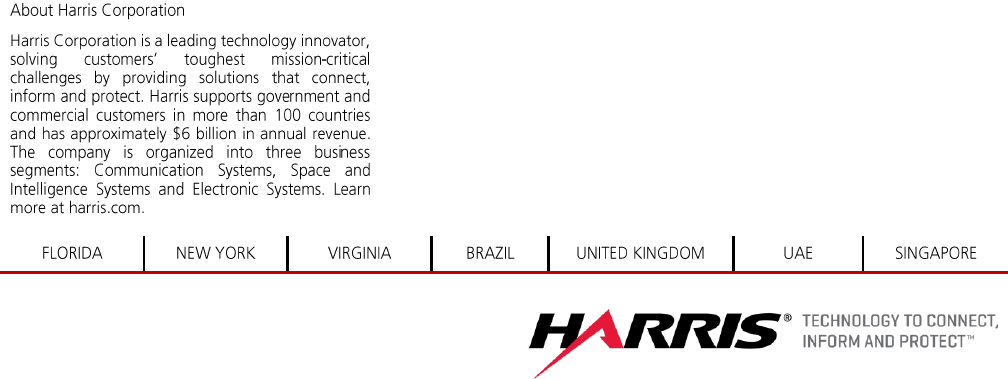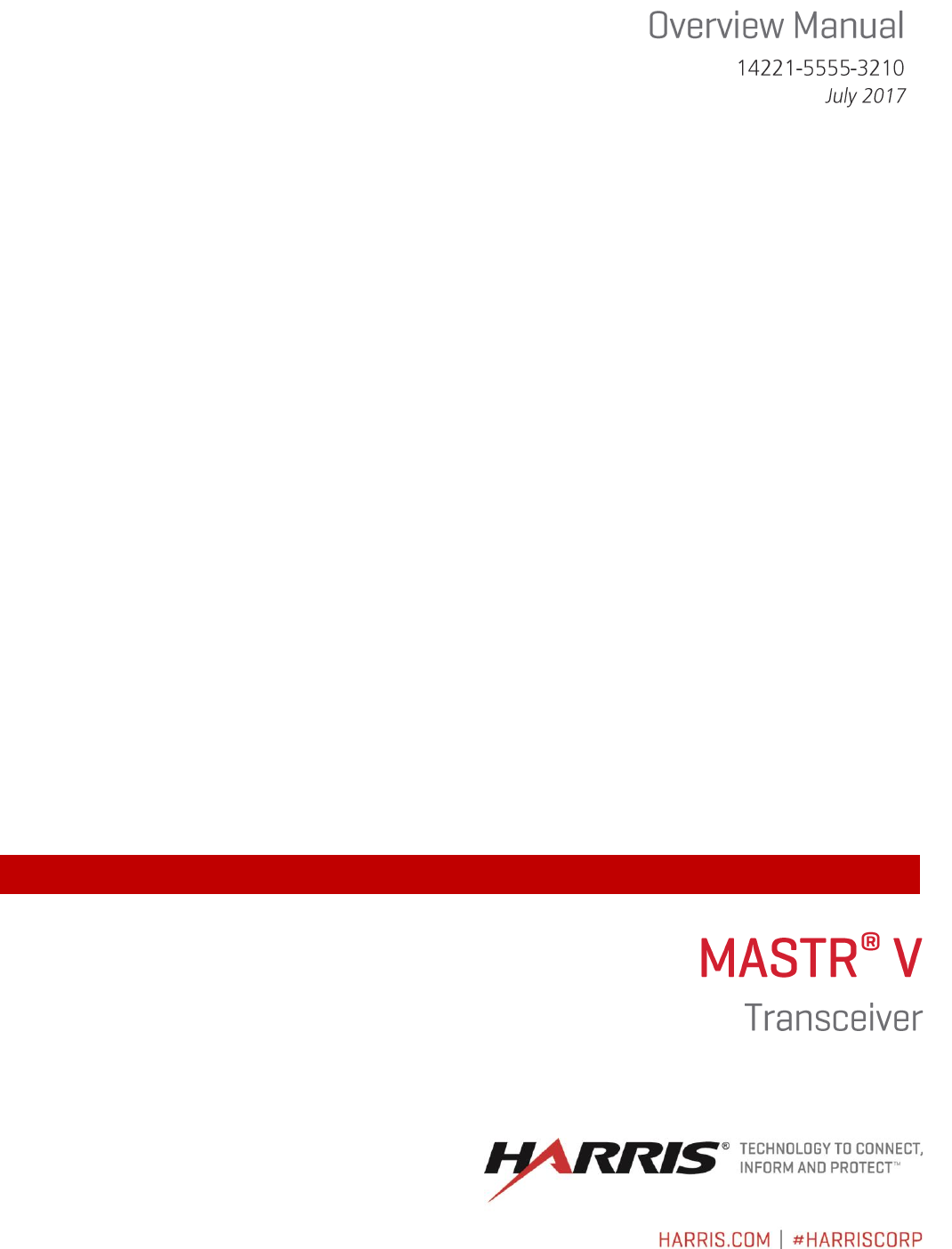HARRIS TR-0155-E MASTR V, Transceiver 900 MHz Band User Manual
HARRIS CORPORATION MASTR V, Transceiver 900 MHz Band
HARRIS >
User Manual
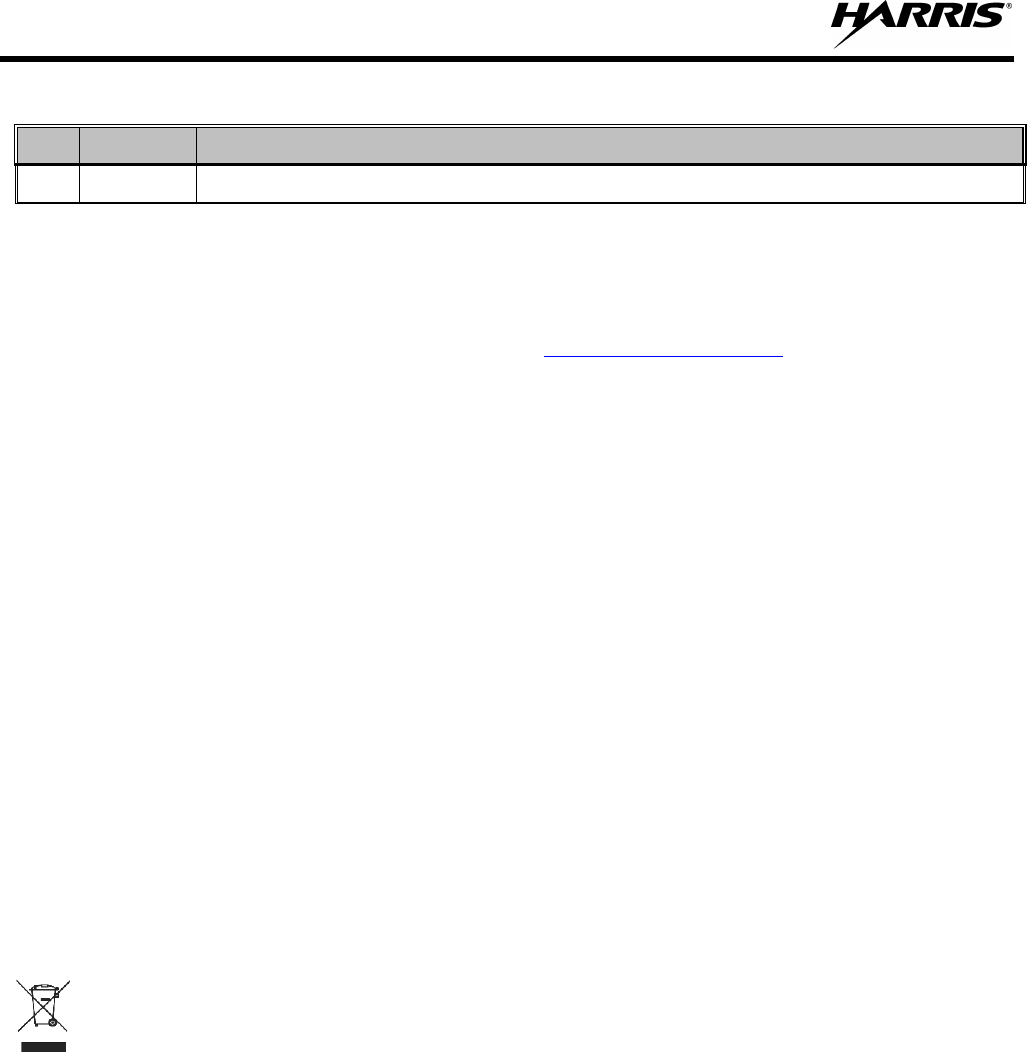
14221-5555-3210
2
MANUAL REVISION HISTORY
REV
DATE
REASON FOR CHANGE
-
Jul/17
Initial release.
Harris Corporation, Public Safety and Professional Communications (PSPC) Business continually evaluates its technical
publications for completeness, technical accuracy, and organization. You can assist in this process by submitting your
comments and suggestions to the following
Harris Corporation fax your comments to: 1-434-455-6851
PSPC Business or
Technical Publications e-mail us at: PSPC_TechPubs@harris.com
221 Jefferson Ridge Parkway
Lynchburg, VA 24501 ACKNOWLEDGEMENT
This device is made under license under one or more of the following US patents: 4,590,473; 4,636,791; 5,148,482; 5,185,796;
5,271,017; 5,377,229; 4,716,407; 4,972,460; 5,502,767; 5,146,497; 5,164,986; 5,185,795; 5,226,084; 5,247,579; 5,491,772;
5,517,511; 5,630,011; 5,649,050; 5,701,390; 5,715,365; 5,754,974; 5,826,222; 5,870,405; 6,161,089; and 6,199,037 B1. DVSI
claims certain rights, including patent rights under aforementioned U.S. patents, and under other U.S. and foreign patents and
patents pending. Any use of this software or technology requires a separate written license from DVSI.
CREDITS
Harris, VIDA, EDACS, NetworkFirst, and OpenSky are registered trademarks, and TECHNOLOGY TO CONNECT,
INFORM AND PROTECT is a trademark of Harris Corporation. AMBE is a registered trademark and IMBE, AMBE+, and
AMBE+2 are trademarks of Digital Voice Systems, Inc. All brand and product names are trademarks, registered trademarks,
or service marks of their respective holders.
NOTICE!
The material contained herein is subject to U.S. export approval. No export or re-export is permitted without written approval
from the U.S. Government. Rated: EAR99; in accordance with U.S. Dept. of Commerce regulations 15CFR774, Export
Administration Regulations.
Information and descriptions contained herein are the property of Harris Corporation. Such information and descriptions may
not be copied or reproduced by any means, or disseminated or distributed without the express prior written permission of Harris
Corporation, PSPC Business, 221 Jefferson Ridge Parkway, Lynchburg, VA 24501.
Repairs to this equipment should be made only by an authorized service technician or facility designated by the supplier. Any
repairs, alterations, or substitutions of recommended parts made by the user to this equipment not approved by the manufacturer
could void the user's authority to operate the equipment in addition to the manufacturer's warranty.
This product conforms to the European Union WEEE Directive 2012/19/EU. Do not dispose of this
product in a public landfill. Take it to a recycling center at the end of its life.
This manual is published by Harris Corporation without any warranty. Improvements and changes to this manual necessitated by typographical errors,
inaccuracies of current information, or improvements to programs and/or equipment, may be made by Harris Corporation at any time and without notice.
Such changes will be incorporated into new editions of this manual. No part of this manual may be reproduced or transmitted in any form or by any means,
electronic or mechanical, including photocopying and recording, for any purpose, without the express written permission of Harris Corporation.
Copyright © 2017, Harris Corporation.

14221-5555-3210
3
TABLE OF CONTENTS
Section Page
1. REGULATORY AND SAFETY INFORMATION ............................................................................. 6
1.1 SAFETY SYMBOL CONVENTIONS ......................................................................................... 6
1.2 IMPORTANT SAFETY INSTRUCTIONS .................................................................................. 6
1.3 MAXIMUM PERMISSIBLE EXPOSURE LIMITS .................................................................... 8
1.4 DETERMINING MPE RADIUS .................................................................................................. 8
1.5 SAFETY TRAINING INFORMATION ...................................................................................... 8
1.6 REGULATORY APPROVALS ................................................................................................... 9
1.6.1 Federal Communications Commission ............................................................................ 9
2. SPECIFICATIONS ............................................................................................................................... 10
3. INTRODUCTION ................................................................................................................................. 12
4. MASTR V TRANSCEIVER OVERVIEW ......................................................................................... 13
4.1 MULTI-CHANNEL TRANSCEIVER SHELF ASSEMBLY .................................................... 13
4.2 MULTI-CHANNEL TRANSCEIVER SHELF .......................................................................... 14
4.3 HIGH POWER AMPLIFIER/POWER SUPPLY SHELF ASSEMBLY ................................... 15
4.4 MASTR V MODULES ............................................................................................................... 15
4.4.1 Ethernet Switch (E-Switch) ............................................................................................ 15
4.4.2 Transmitter Module (TX) ............................................................................................... 16
4.4.3 Receiver Module (RX) ................................................................................................... 18
4.4.4 Baseband Processor Module (BBP) ............................................................................... 19
4.4.5 Traffic Controller Module (TC) ..................................................................................... 22
4.4.6 AC and DC Power Distribution ..................................................................................... 26
4.4.7 Cross-Connect Panel ...................................................................................................... 27
4.5 RACK AND CABINET ASSEMBLIES .................................................................................... 28
4.5.1 DC-to-AC Inverter ......................................................................................................... 29
5. PROGRAMMING, TEST, AND DIAGNOSTICS ............................................................................. 30
5.1 VIDA DEVICE MANAGER ...................................................................................................... 30
5.2 TEST AND DIAGNOSTICS ...................................................................................................... 30
6. REFERENCE MANUALS ................................................................................................................... 31
7. CUSTOMER SERVICE ....................................................................................................................... 32
7.1 TECHNICAL SUPPORT ............................................................................................................ 32
7.2 TECH-LINK ONLINE SERVICES ............................................................................................ 32
7.3 CUSTOMER CARE ................................................................................................................... 32
8. WARRANTY ......................................................................................................................................... 33

14221-5555-3210
4
FIGURES
Figure 3-1: MASTR V Multi-Channel Transceiver Shelf Equipped with One (1) RF Channel ................... 12
Figure 4-1: MASTR V MHz Transciever Shelf equipped with Four (4) RF Channels ................................. 13
Figure 4-2: 14-Slot Transceiver Shelf ........................................................................................................... 14
Figure 4-3: MASTR V HPA/PS Shelf Assembly (Shown with HPA and PS Installed) ............................... 15
Figure 4-4: Ethernet Switch Module ............................................................................................................. 16
Figure 4-5: TX Module ................................................................................................................................. 17
Figure 4-6: RX Module ................................................................................................................................. 19
Figure 4-7: Baseband Processor Module ....................................................................................................... 22
Figure 4-8: Traffic Controller Module .......................................................................................................... 23
Figure 4-9: Power Supply Module ................................................................................................................. 24
Figure 4-10: Dual input 120VAC Power Distribution Strip ........................................................................... 26
Figure 4-11: EA-555019-001 – -48 VDC Low Power DC Distribution Strip................................................ 26
Figure 4-12: EA-555019-002 – -48 VDC High Power DC Distribution Strip ............................................... 26
Figure 4-13: EA-555019-003 – Enhanced -48 VDC Low Power DC Distribution Strip ............................... 27
Figure 4-14: EA-555019-004 – Enhanced -48 VDC High Power DC Distribution Strip .............................. 27
Figure 4-15: IP Simulcast Cross-Connect Board CB-555149-002 ................................................................. 28
Figure 4-16: 86-inch Open Rack Assembly ................................................................................................... 28
Figure 4-17: 86-inch Extra Deep Cabinet ....................................................................................................... 28
Figure 4-18: Seismic Rated Open Rack Assembly......................................................................................... 28
Figure 4-19: DC-to-AC Inverter Used to Power the Cabinet Fan at DC-Powered Sites ................................ 29
TABLES
Table 4-1: Typical Module Slot Assignments for MASTR V Transceiver ................................................... 13
Table 4-2: E-Switch Module Connections .................................................................................................... 15
Table 4-3: Ethernet Switch – Front Panel Indicators and Controls ............................................................... 16
Table 4-4: TX Module Connections .............................................................................................................. 17
Table 4-5: TX Module – Front Panel Indicators and Controls ...................................................................... 18
Table 4-6: RX Module Connections .............................................................................................................. 19
Table 4-7: RX Module – Front Panel Indicators and Controls ...................................................................... 19
Table 4-8: BBP Module Connections ............................................................................................................ 20
Table 4-9: BBP Module – Front Panel Indicators and Controls ..................................................................... 20
Table 4-10: TC Module Connections ............................................................................................................. 22

14221-5555-3210
5
TABLE OF CONTENTS
Section Page
Table 4-11: TC Module – Front Panel Indicators and Controls ..................................................................... 23
Table 4-12: Backplane – Module DC Power Connector Pinout ..................................................................... 25
Table 4-13: PS Front Panel Indicators and Switches ..................................................................................... 25
Table 6-1: Reference Manuals ....................................................................................................................... 31
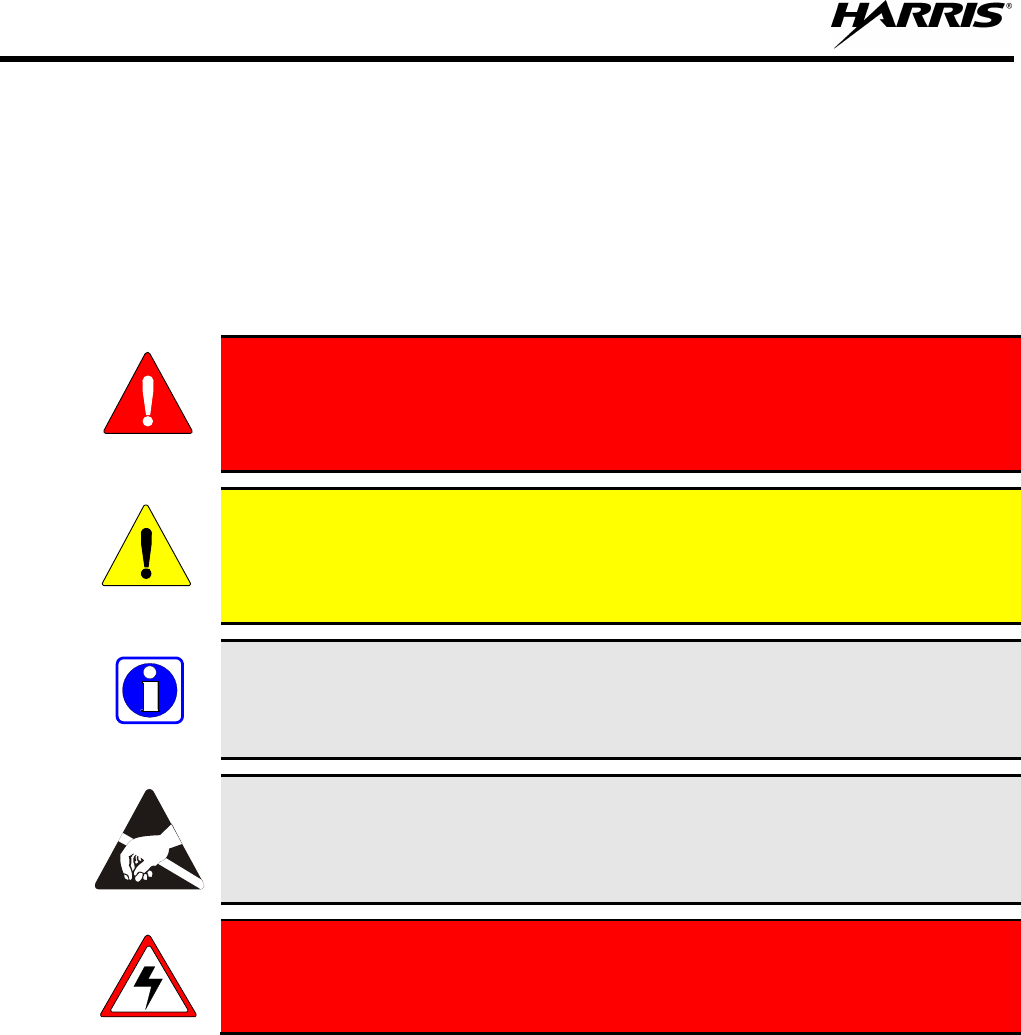
14221-5555-3210
6
1. REGULATORY AND SAFETY INFORMATION
1.1 SAFETY SYMBOL CONVENTIONS
The following conventions are used throughout this manual to alert the user to general safety precautions
that must be observed during all phases of operation, service, and repair of this product. Failure to comply
with these precautions or with specific warnings elsewhere violates safety standards of design, manufacture,
and intended use of the product. Harris assumes no liability for the customer’s failure to comply with these
standards.
The WARNING symbol calls attention to a procedure, practice, or the like, which,
if not correctly performed or adhered to, could result in personal injury. Do not
proceed beyond a WARNING symbol until the conditions identified are fully
understood or met.
The CAUTION symbol calls attention to an operating procedure, practice, or the like,
which, if not performed correctly or adhered to, could result in damage to the equipment
or severely degrade equipment performance.
The NOTE symbol calls attention to supplemental information, which may improve
system performance or clarify a process or procedure.
The ESD symbol calls attention to procedures, practices, or the like, which could expose
equipment to the effects of Electro-Static Discharge. Proper precautions must be taken to
prevent ESD when handling circuit boards or modules.
The electrical hazard symbol is a WARNING indicating there may be an electrical
shock hazard present.
1.2 IMPORTANT SAFETY INSTRUCTIONS
• Read these instructions.
• Keep these instructions.
• Heed all warnings.
• Follow all instructions.
• Do not use this apparatus near water.
• Clean only with dry cloth.
• Where required, this equipment shall be installed in a restricted access location.
WARNING
CAUTION
NOTE
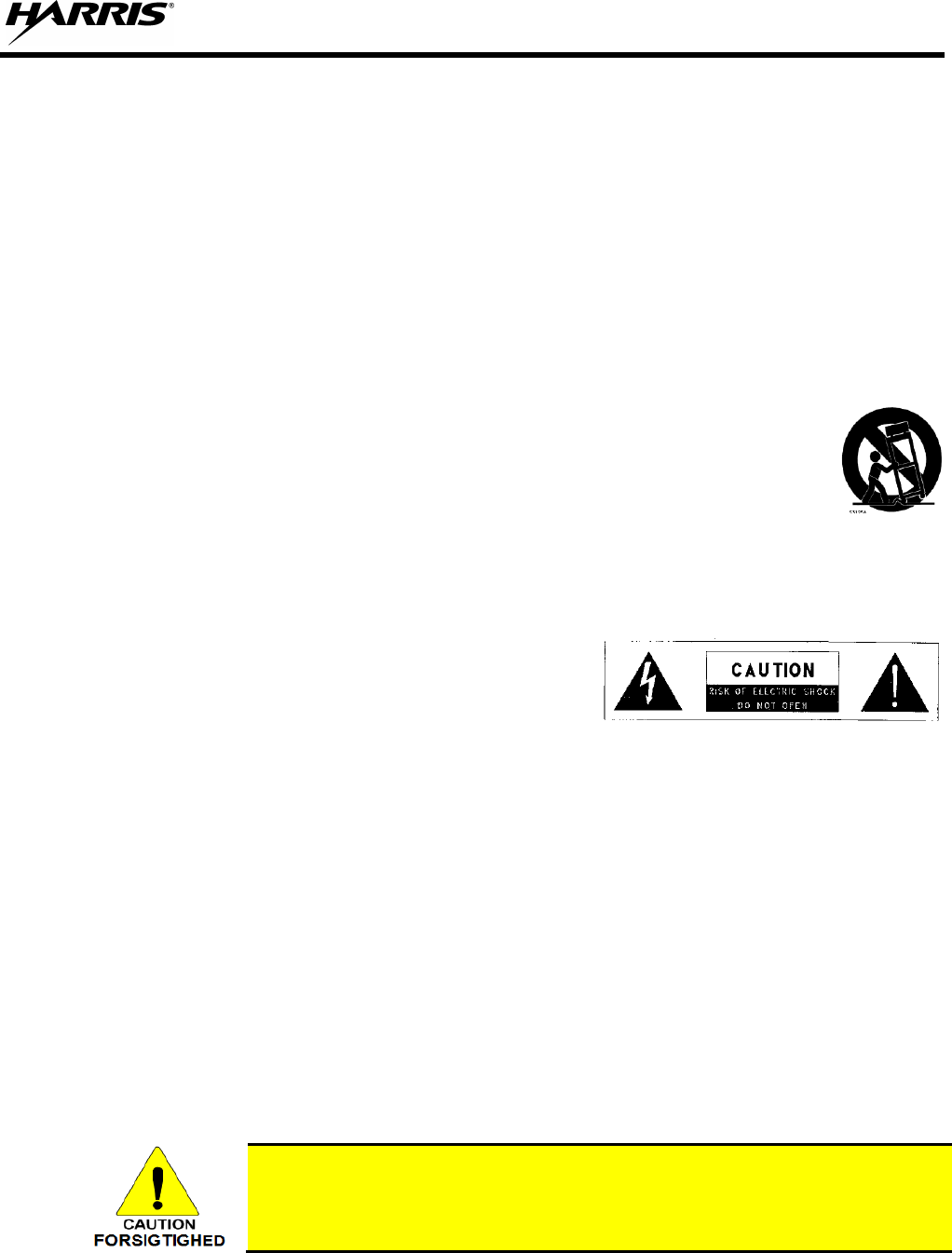
14221-5555-3210
7
• The power socket-outlet shall be installed near the equipment and shall be easily accessible.
• Do not block any ventilation openings. Install in accordance with the manufacturer’s instructions.
• Do not install near any heat sources such as radiators, heat registers, stoves, or other apparatus
(including amplifiers) that produce heat.
• Do not defeat the safety purpose of the polarized or grounding-type plug. A polarized plug has two
blades with one wider than the other. A grounding type plug has two blades and a third grounding
prong. The wide blade or the third prong is provided for your safety. If the provided plug does not fit
into your outlet, consult an electrician for replacement of the obsolete outlet.
• Protect the power cord from being walked on or pinched; particularly at plugs, convenience receptacles,
and the point where they exit from the apparatus.
• Only use attachments/accessories specified by the manufacturer.
• Use only with the cart, stand, tripod, bracket, or table specified by the manufacturer, or
sold with the apparatus. When a cart is used, use caution when moving the
cart/apparatus combination to avoid injury from tip-over.
• Refer all servicing to qualified service personnel. Servicing is required when the apparatus has been
damaged in any way, such as when the power-supply cord or plug is damaged, liquid has been spilled
or objects have fallen into the apparatus, the apparatus has been exposed to rain or moisture, does not
operate normally, or has been dropped.
• Warning: The lightning bolt signifies an alert to the user
of the presence of un-insulated “dangerous voltage”
within the product’s enclosure that may be of significant
magnitude to constitute a risk of electric shock to persons.
• Warning: The exclamation point alerts the user to the presence of important operation and maintenance
(service) instructions in the literature accompanying the product.
• Outdoor Use Warning: To reduce the risk of Fire or Electric Shock, Do Not Expose This Apparatus to
Rain or Moisture.
• Wet Location Warning: Apparatus shall not be exposed to dripping or splashing and no objects filled
with liquids, such as vases, shall be placed on the apparatus.
• The building installation shall provide a means for connection to the protective earthing and the
equipment shall be connected to that means.
• For permanently connected equipment, a readily accessible power disconnect device shall be
incorporated external to the equipment.
• A service person shall check whether or not the socket-outlet from which the equipment is to be
powered provides a connection to the building protective earth. If not, the service person shall arrange
for installation of a protective earthing conductor from the separate protective earthing terminal to the
protective earth wire in the building.
The equipment must be connected to an earthed mains socket-outlet.
Udstyret skal tilsluttes en jordet stikkontakt.
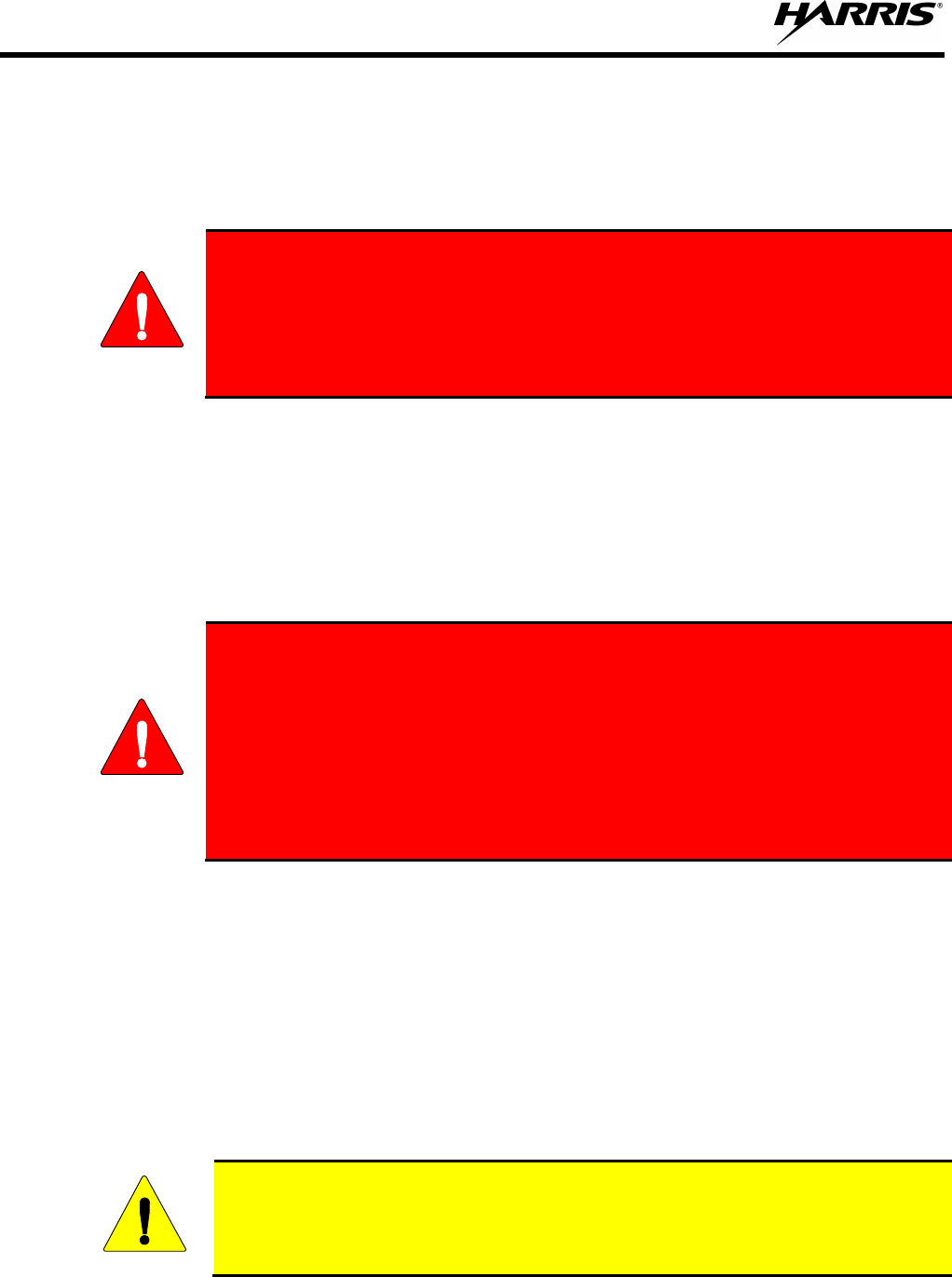
14221-5555-3210
8
1.3 MAXIMUM PERMISSIBLE EXPOSURE LIMITS
DO NOT TRANSMIT with this transceiver and antenna when persons are within the Maximum Permissible
Exposure (MPE) Radius of the antenna. The MPE Radius is the minimum distance from the antenna axis
that ALL persons should maintain in order to avoid RF exposure higher than the allowable MPE level set
by the FCC.
Failure to observe these limits may allow all persons within the MPE radius to
experience RF radiation absorption, which exceeds the FCC maximum permissible
exposure (MPE) limit. It is the responsibility of the transceiver operator to ensure
that the maximum permissible exposure limits are observed at all times during
transceiver transmission. The transceiver licensee is to ensure that no bystanders
are within the radius limits.
1.4 DETERMINING MPE RADIUS
The Maximum Permissible Exposure radius is unique for each site and is determined during site licensing
time based on the complete installation environment (i.e., co-location, antenna type, transmit power level,
etc.). Determination of the MPE distance is the responsibility of the installation licensee. Calculation of
the MPE radius is required as part of the site licensing procedure with the FCC.
1.5 SAFETY TRAINING INFORMATION
Your MASTR®V transceiver generates RF electromagnetic energy during transmit
mode. This transceiver is designed for and classified as “occupational use only”
meaning it must be used only in the course of employment by individuals aware of
the hazards and the ways to minimize such hazards. This transceiver is not intended
for use by the “general population” in an uncontrolled environment. It is the
responsibility of the transceiver licensee to ensure that the maximum permissible
exposure limits determined in the previous section are observed at all times during
transmission. The transceiver licensee is to ensure that no bystanders come within
the radius of the maximum permissible exposure limits.
When licensed by the FCC, this transceiver complies with the FCC RF exposure limits when persons are
beyond the MPE radius of the antenna. In addition, your Harris transceiver installation complies with the
following Standards and Guidelines with regard to RF energy and electromagnetic energy levels and
evaluation of such levels for exposure to humans:
• FCC OET Bulletin 65 Edition 97-01 Supplement C, Evaluating Compliance with FCC Guidelines for
Human Exposure to Radio Frequency Electromagnetic Fields.
• American National Standards Institute (C95.1 – 1992), IEEE Standard for Safety Levels with Respect
to Human Exposure to Radio Frequency Electromagnetic Fields, 3 kHz to 300 GHz.
• American National Standards Institute (C95.3 – 1992), IEEE Recommended Practice for the
Measurement of Potentially Hazardous Electromagnetic Fields – RF and Microwave.
To ensure that your exposure to RF electromagnetic energy is within the FCC allowable
limits for occupational use, do not operate the transceiver in a manner that would create
an MPE distance in excess of that allowable by the FCC.
WARNING
WARNING
CAUTION
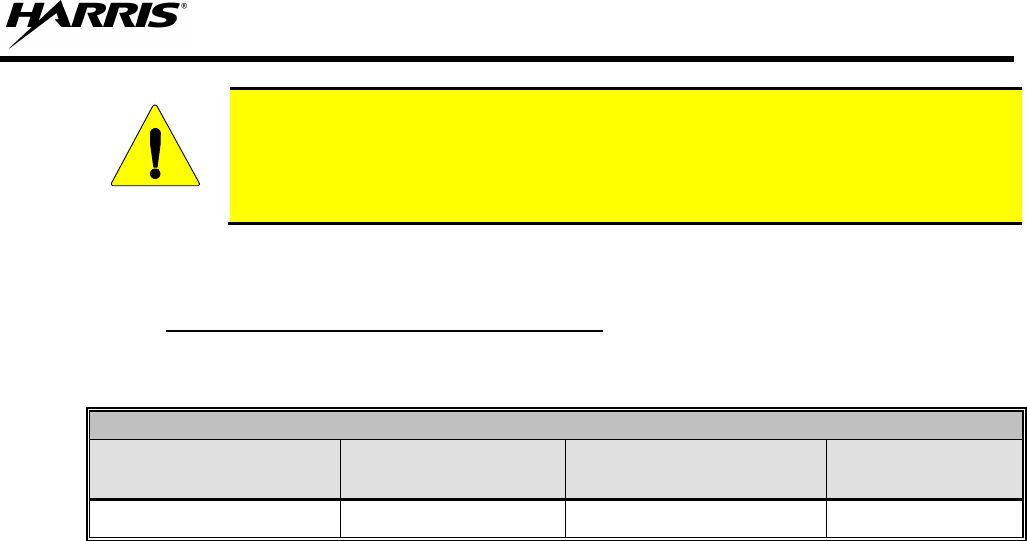
14221-5555-3210
9
This equipment generates or uses radio frequency energy. Any changes or modifications
to this equipment not expressly approved by Harris may cause harmful interference and
could void the user’s authority to operate the equipment.
1.6 REGULATORY APPROVALS
1.6.1 Federal Communications Commission
The transmitting device described within this manual has been tested and found to meet the following
regulatory requirements:
FCC FILING DATA FOR MASTR V TRANSCEIVER
FREQUENCY BAND
(MHz)
POWER OUTPUT
(Watts)
FCC TYPE
ACCEPTANCE NUMBER
APPLICABLE
FCC RULES
935 - 940
0.001
OWDTR-0155-E
Part 90
This receiver associated with this transmitting device has been tested and declared to meet the regulatory
requirements defined in the following sub-sections.
1.6.1.1 FCC Compliance
This device complies with Part 15 of the FCC Rules. Operation is subject to the following two conditions:
1. This device may not cause harmful interference, and,
2. This device must accept any interference received, including interference that may cause undesired
operation.
1.6.1.2 Information to the User
This equipment has been tested and found to comply with the limits for a Class B digital device, pursuant
to Part 15 of the FCC Rules. These limits are designed to provide reasonable protection against harmful
interference in a residential installation. This equipment does generate, use, and can radiate radio frequency
energy and, if not installed and used in accordance with the instructions, may cause harmful interference to
radio communications. However, there is no guarantee that interference will not occur in a particular
installation. If this equipment does cause harmful interference to radio or television reception, which can
be determined by turning the equipment off and on, the user is encouraged to try to correct the interference
by one or more of the following measures:
• Reorient or relocate the receiving antenna.
• Increase the separation between the equipment and receiver.
• Connect the equipment into an AC outlet on a circuit different from that which the receiver is connected.
• Consult the dealer or an experienced radio/TV technician for help.
CAUTION

14221-5555-3210
10
2. SPECIFICATIONS
General Specifications1
Duty Cycle (EIA) Continuous:
Transmit and Receive at 100%
Operating Temperature:
-22°F to +140°F (-30°C to +60°C)
Humidity (EIA):
90-95% at 122°F (50°C) Non-condensing
Power Supplies:
AC Supply (EA-555011-001)
DC Supply (EA-555011-003)
Input Power Source:
90 – 240 VAC (nom.), 47~63 Hz
-48VDC (+/- 20%), 25.0 Amp
Power Supply Outputs: +28.0 VDC± 0.2V:
+12.0 VDC± 0.2V:
+5.0 VDC± 0.2V:
25.0 Amps
2.8 Amps
28.0 Amps
25.0 Amps
5.0 Amps
15.0 Amps
Source Power Drain:
50 watts per channel (max.), 40 watts per channel (typical)
Altitude:
Operational:
Up to 13,123 ft. (4,000 m)
Shippable:
Up to 50,000 ft. (15,250 m)
Transmitter Specifications
Frequency Ranges:
935 - 941 MHz
RMS RF Output Power2:
0.001 Watts
RF Output Impedance:
50 ohms
Antenna Connection:
SMB JACK on TX Module
Frequency Stability:
< 0.1 ppm external freq. std.3
Frequency Step Size:
6.25 kHz
Tuning Range:
No tuning required
Nominal TX Deviation:
2.544 to 3.111 kHz (per TIA-102)
Modes of Modulation:
P25 Phase 1
P25 Linear Simulcast
P25 Phase 2
MODULATION TYPE EMISSION DESIGNATOR
C4FM 8K00F1D, 8K00F1E
WCQPSK 9K70D1W
HDQPSK 9K80D7W
Modulation Emission Spectrum:
Per FCC Part 90
Radiated and Conducted Spurious Emissions:
900 MHz Transceiver: < -70 dBc
Receiver Specifications
Frequency Range:
896 - 902 MHz
Tuning Range:
Receiver modules (all bands), No tuning required
RF Input Impedance:
50 ohms
Antenna Connection:
SMA Female on Receiver Module
1
Specifications listed herein are applicable only to Harris’ MASTR V Transceiver RF equipment. Always refer to the manufacturer of third party equipment,
such as Routers and Switches, for additional specifications. Specifications listed in this manual are intended primarily for the use of the service technician.
Additional specifications may be listed on the product data sheet.
2
Rated power output is measured at the transmitter’s output connector. Optional items such as power measuring devices and/or duplexers will introduce
loss between the transmitter output connector and the cabinet output connector. This loss will reduce the available power at the cabinet output connector.
3
Beginning with Baseband processor Rev. D, an external reference is no longer required to meet this specification.

14221-5555-3210
11
Channel Spacing:
12.5 kHz
Sensitivity:
≥ -119 dBm (5% BER) static, -111 faded (EIA)
Selectivity:
≥ 60 dB Per TIA-102
Frequency Stability:
< 0.1 ppm external freq. std.3
Signal Displacement Bandwidth:
± 1.0 kHz Per TIA-102
Spurious and Image Rejection:
≥ 90 dB
Weights and Dimensions4
WEIGHT
lbs. (kg.)
DEPTH
in (cm)
WIDTH
in (cm)
HEIGHT5
in (cm) or RU
Rack, 86 in., Deep, 3-rail, 46-RU:
235 (107)
21.0 (53.3)
21.0. (53.3)
85.5 (217.0)
Cabinet, 86 in., Extra Deep, 45-RU
355 (161.0)
31.6 (80.3)
23 (58.4)
86.8 (220.5)
14-Slot Shelf Assembly (w/o modules):
16.5 (7.5)
15.0 (38.1)
19.0 (48.3)
5-RU
High Power Amplifier Shelf (Chassis only):
5.0 (2.3)
19.0 (48.3)
2-RU
Power Supply Unit (PSU):
9.0 (4.1)
13 (33.0)
8.6 (21.8)
3.5 (8.9)
Ethernet Switch:
0.8 (0.36)
12.25 (31.1)
0.625 (1.6)
4.25 (10.8)
Transmitter (TX) Module:
2.5 (1.1)
12.6 (32.0)
0.82 (2.1)
7.25 (18.4)
Receiver (RX) Module:
2.5 (1.1)
12.6 (32.0)
0.82 (2.1)
7.25 (18.4)
Traffic Controller (TC) Module:
2.5 (1.1)
12.6 (32.0)
0.82 (2.1)
7.25 (18.4)
Baseband Module (BB):
2.5 (1.1)
12.6 (32.0)
0.82 (2.1)
7.25 (18.4)
4
Weights and dimensions are approximate, and represent the minimum space required to install the device. In most cases, measurements include handles,
brackets, knobs, controls, and other hardware that is permanently affixed to the device. Measurements do not include distances for cable bends, unless the
cable is permanently affixed to the equipment.
5
For 19” rack mountable equipment, heights may be defined in Rack Units (RU). One (1) RU is equal to 1.75 in. (4.45 cm). For example: 2-RU equals 3.5
in. (8.9 cm), 3-RU equals 5.25 in. (13.3 cm), etc.
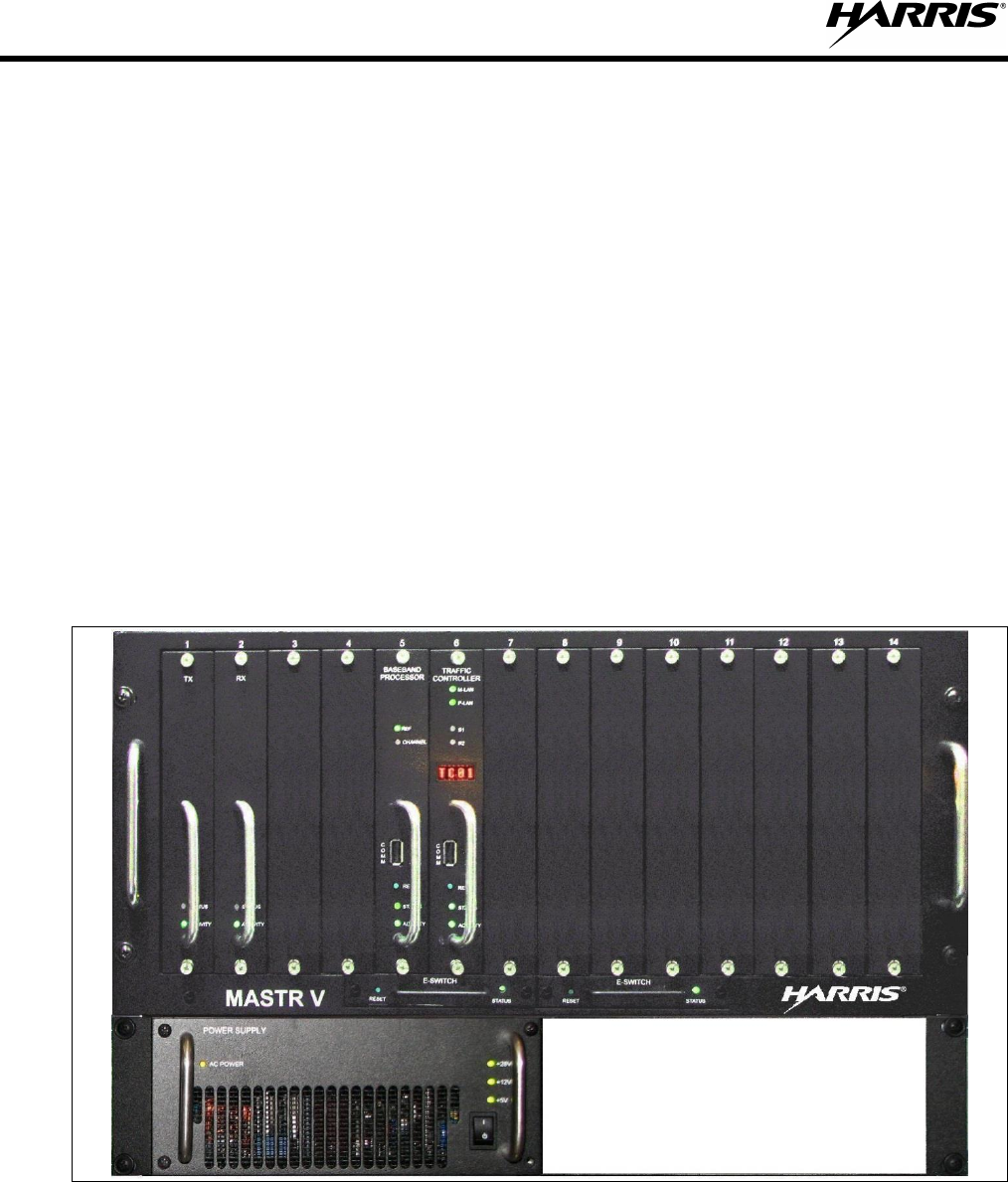
14221-5555-3210
12
3. INTRODUCTION
The MASTR V Transceiver is a P25 Phase 2 capable. The MASTR V Transceiver is a digital, IP based,
LMR communications transceiver operating within a compact shelf design. It supports IP-based remote
software uploads and configuration. IP-based programming may be accomplished using the VIDA® Device
Manager programming tool. Network and programming communications ports may be configured for
VIDA secure shell operation to meet Information Assurance (IA) requirements. A Built-In Self Test (BIST)
feature provides improved performance through remote diagnosis which minimizes down time.
The MASTR V Transceiver uses a 14-slot modular multi-channel T/R shelf assembly (refer to Figure 3-1)
and a 2-slot High Power Amplifier/Power Supply (HPA/PS) shelf assembly. Modules may include
Baseband Processors, Traffic Controllers, TX, and RX modules. Blank panels for the main module slots
(MA-555413) and for the E-Switch slots (MA-555417) are installed in unused slots.
The TX module uses circuitry capable of generating any LMR modulation format.
The RX module includes integrated front end and IF circuitry. The RX module also uses IQ demodulation
circuitry. The IQ demodulator can decode most amplitude and phase modulation characteristic, making it
capable of receiving analog or digital LMR modulation format.
The Multi-Channel T/R shelf requires +12 VDC and +5 VDC. The transceiver may be equipped with a
120/240 VAC switching power supply or -48 VDC power supply. The T/R shelf occupies 5-RU spaces.
The HPA/PS shelf occupies 2-RU spaces (per TX channel).
Figure 3-1: MASTR V Multi-Channel Transceiver Shelf Equipped with One (1) RF Channel
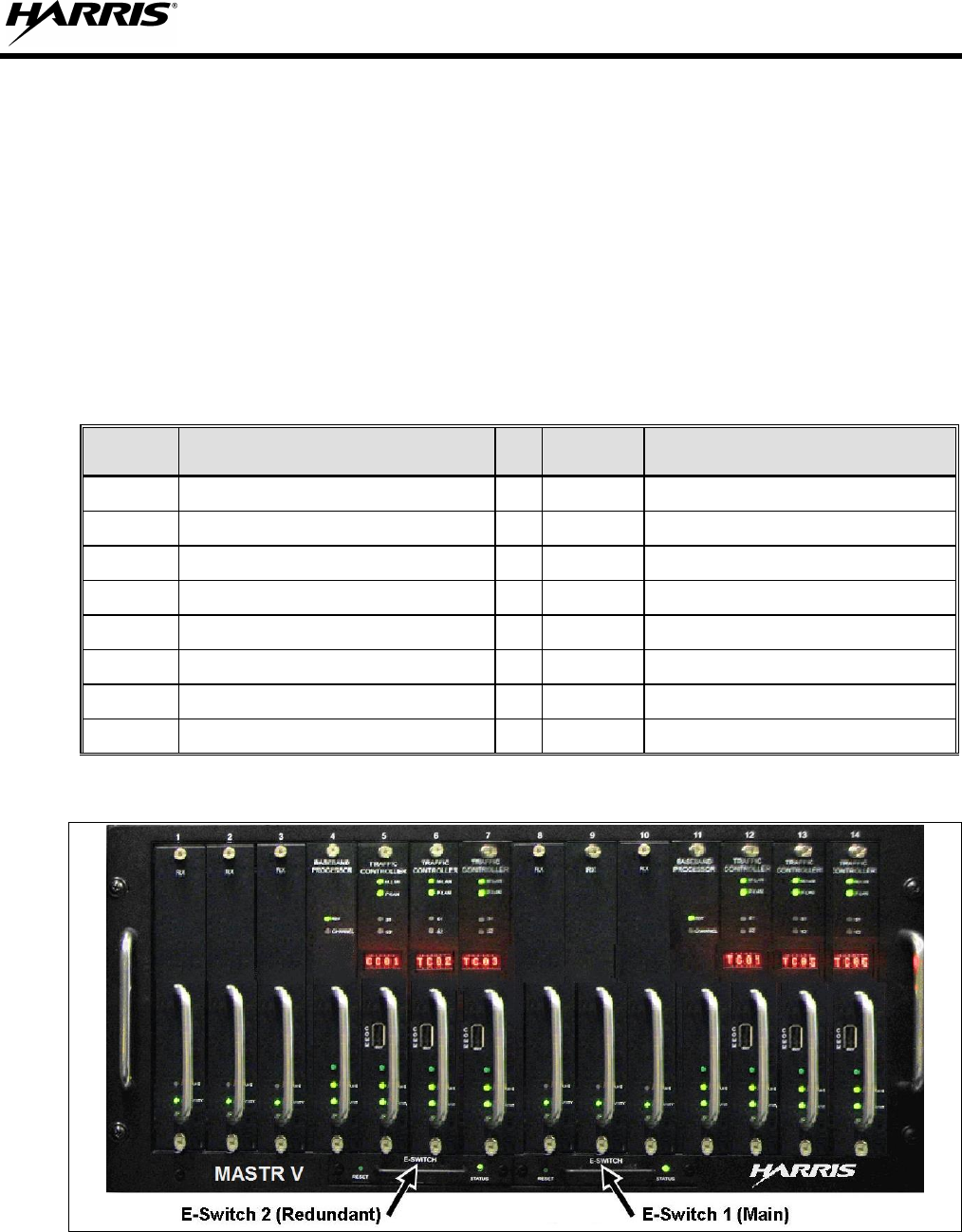
14221-5555-3210
13
4. MASTR V TRANSCEIVER OVERVIEW
4.1 MULTI-CHANNEL TRANSCEIVER SHELF ASSEMBLY
The MASTR V multi-channel transceiver shelf assembly is a unified sub-rack design providing 14 identical
vertical module slots. Also included are two (2) horizontal slots located under the 14 vertical slots, and
used to connect the built-in main and redundant Ethernet Switch modules.
A backplane assembly provides data and DC power connections to each vertical slot, and the two Ethernet
Switch module slots. The multi-channel transceiver shelf, and each module, is equipped with a pull handle
for improved handling of the equipment.
Table 4-1: Typical Module Slot Assignments for MASTR V Transceiver
SLOT #
MODULE
SLOT #
MODULE
1
Transmitter Module (Channel 1)
8
Transmitter Module (Channel 3)
2
Receiver Module (Channel 1)
9
Receiver Module (Channel 3)
3
Transmitter Module (Channel 2)
10
Transmitter Module (Channel 4)
4
Receiver Module (Channel 2)
11
Receiver Module (Channel 4)
5
Baseband Module (Channel 1 / 2)
12
Baseband Module (Channel 3 / 4)
6
Traffic Controller (Channel 1)
13
Traffic Controller (Channel 3)
7
Traffic Controller (Channel 2)
14
Traffic Controller (Channel 4)
E1
E-Switch # 1 (Main)
E2
E-Switch #2 (Redundant)
Figure 4-1: MASTR V MHz Transceiver Shelf equipped with Four (4) RF Channels
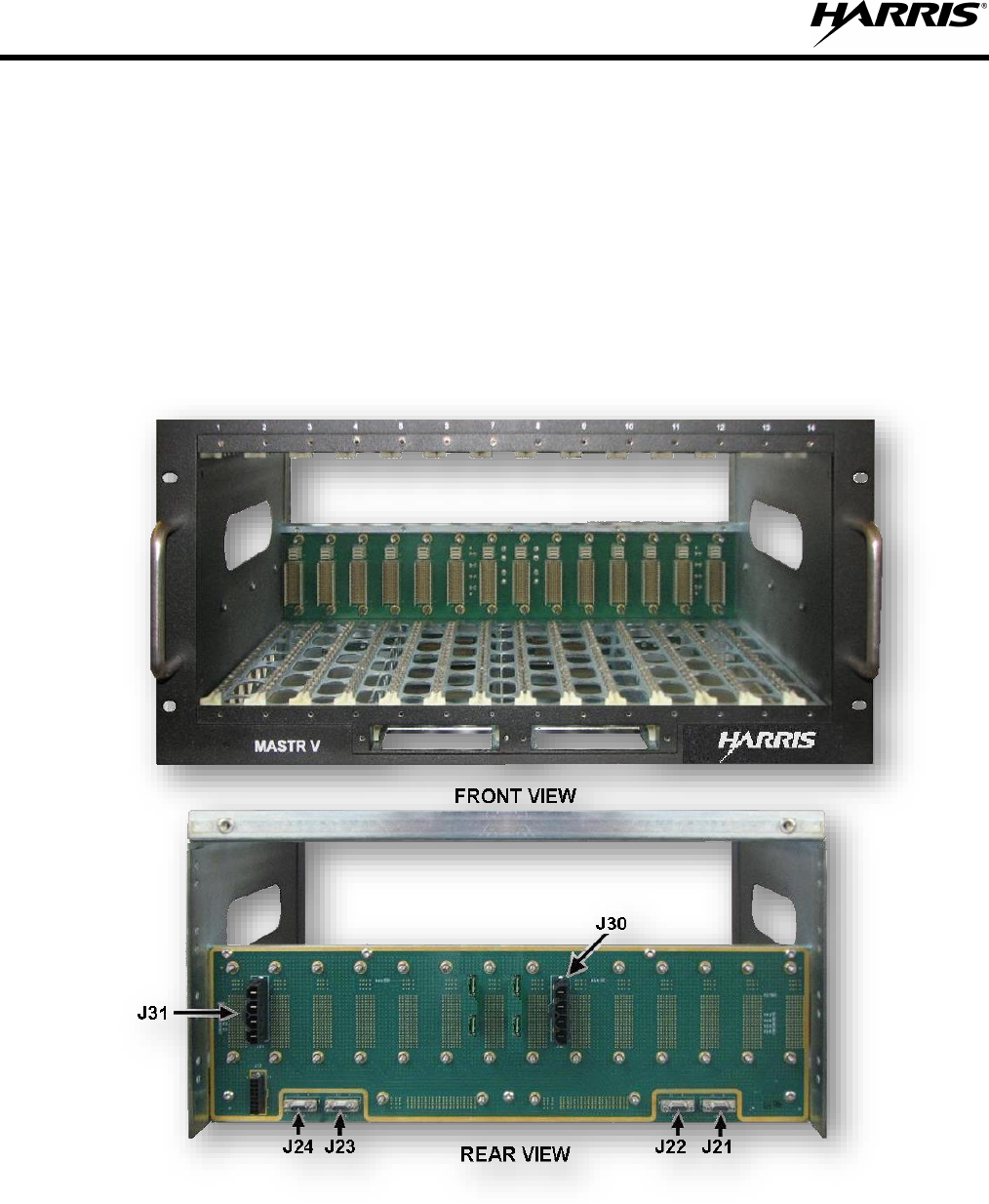
14221-5555-3210
14
4.2 MULTI-CHANNEL TRANSCEIVER SHELF
The MASTR V Multi-Channel Transceiver shelf model EA-555002-001 is a 14-slot, 5-RU, shelf assembly.
The shelf provides a modular environment supporting almost any combination of MASTR V modules.
Assembled to the rear of the shelf is a unified backplane assembly. The backplane interfaces all data,
frequency reference, and DC power connections from the 14 module slots, to the two (2) horizontally
positioned Ethernet switch modules.
Connectors J30 and J31 are DC inputs for the backplane. Two (2) connector assemblies are provided for
each module slot; a 3-pin connector for DC power (J101 through J114) and a 95-pin connector for
data/small signals (J1 through J14). Each E-Switch module slot uses a 120-pin signal connector having 40
balanced signal pairs, and each pair having an individual shield for optimal signal performance.
Additionally, two (2) guide pins are used in each module slot, one at each end of every connector row.
Figure 4-2: 14-Slot Transceiver Shelf
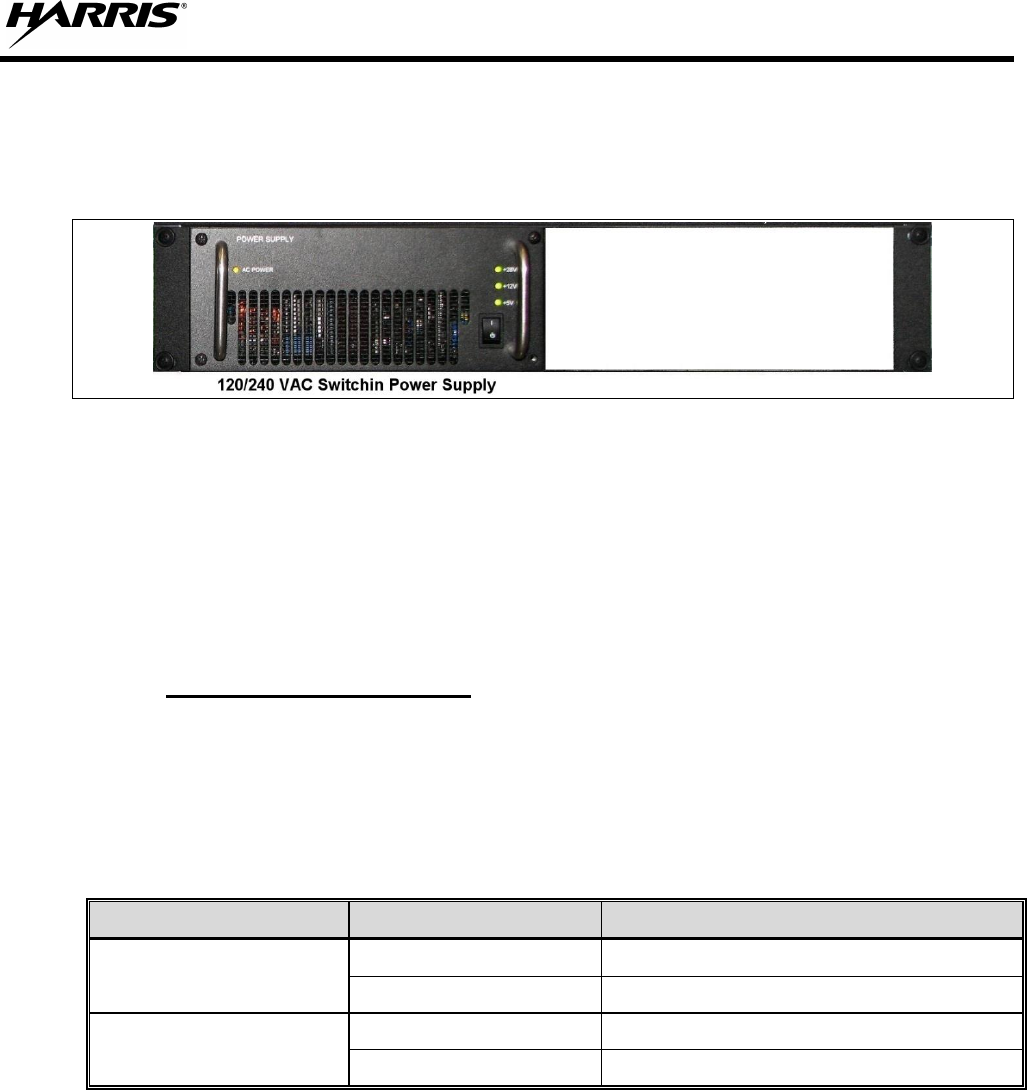
14221-5555-3210
15
4.3 HIGH POWER AMPLIFIER/POWER SUPPLY SHELF ASSEMBLY
The Power Supply (PS) (refer to Section 4.4.5.1) are installed in a 19” rack mountable, 2-slot metal shelf,
model MA-555003 (refer to Figure 4-3). The HPA/PS shelf is a mechanical-only assembly with no
electrical components.
Figure 4-3: MASTR V HPA/PS Shelf Assembly (Shown with PS Installed)
4.4 MASTR V MODULES
For P25 Transceiver operation, the following modules may be installed in the MASTR V Transceiver shelf:
• TX module
• RX module
• Baseband Processor Module
• Traffic Controller Module
• Power Supply Module
• Ethernet Switch
4.4.1 Ethernet Switch (E-Switch)
Communication with the MASTR V transceiver modules is provided by a built-in Ethernet Switch module
EA-555012-001 located under main module shelf. A second position is provided under the main module
shelf for a redundant Ethernet Switch module.
Ethernet communications are utilized to pass voice and data transmissions, management, and control data
between the Traffic Controller and supporting MASTR V modules via the Ethernet Switches.
Table 4-2: E-Switch Module Connections
LOCATION
CONNECTOR
DESCRIPTION
Circuit Board (side)
RJ-45
Factory Service Communications Port
4-Pin
Factory Service DC Power
Rear Panel
120-Pin
Backplane Connection (40 pair w/Shield)
3-Pin
Backplane DC Power
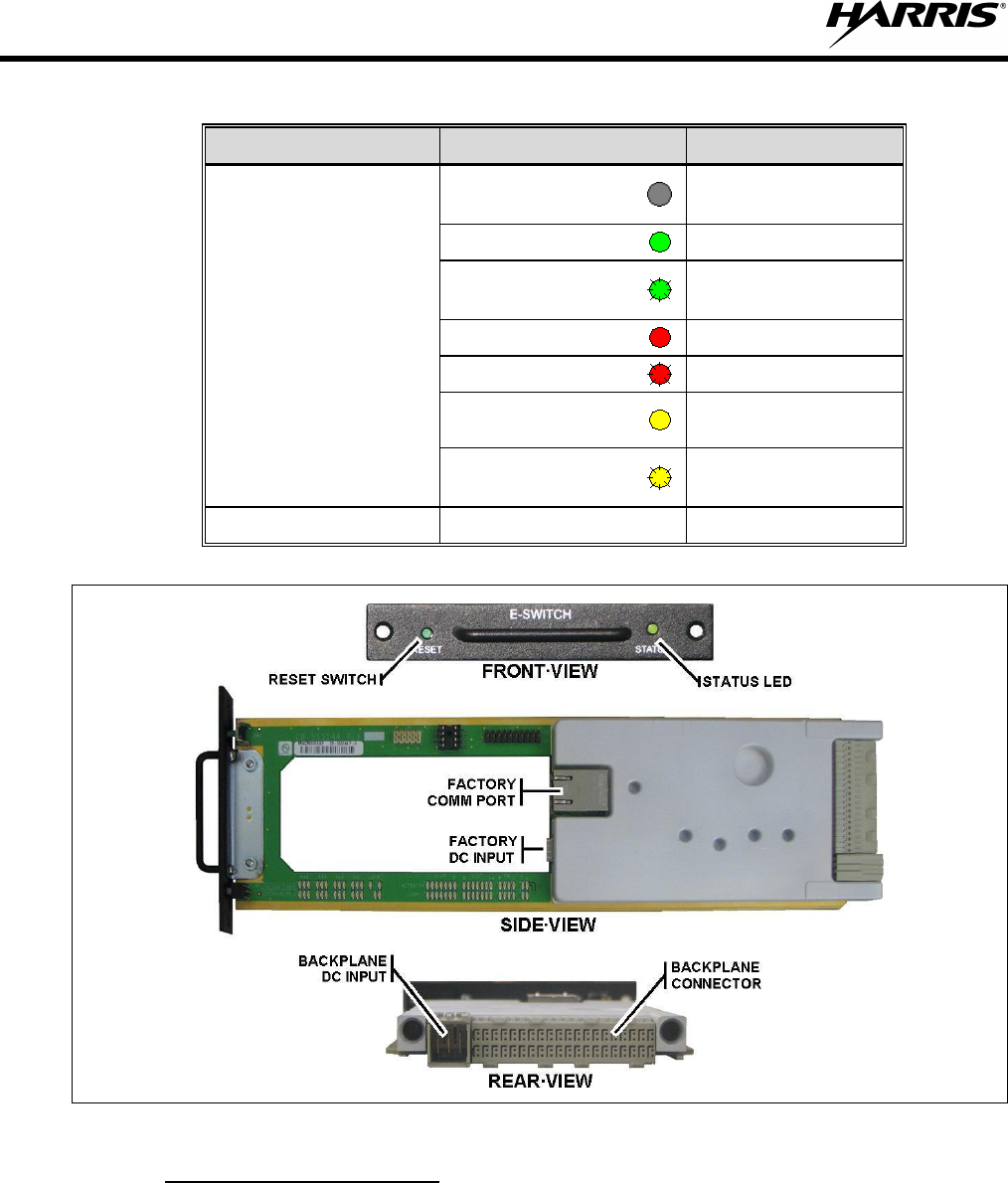
14221-5555-3210
16
Table 4-3: Ethernet Switch – Front Panel Indicators and Controls
INDICATOR/CONTROL
INDICATOR COLOR
DESCRIPTION
Status LED
OFF
No Status (Power
OFF)
GREEN SOLID
Active Switch
GREEN
FLASHING
Standby Switch
RED SOLID
Major Fault
RED FLASHING
Minor Fault
YELLOW SOLID
Flash Write
YELLOW
FLASHING
Program
Downloading
Reset Switch
N/A
Soft Module Reset
Figure 4-4: Ethernet Switch Module
4.4.2 Transmitter Module (TX)
The MASTR V TX module series EA-555008-xxx provides a highly stable 0 dBm RF output. The
MASTR V TX module uses a Direct Digital Synthesizer (DSS) which optimizes the modulation
characteristics of the TX module. DSS can digitally create a precision waveform or modulation scheme
from a single on-board oscillator. This capability makes the MASTR V TX module one of the most
versatile transmitter modules in the North American Land Mobile Radio (LMR) and European Professional
Mobile Radio (PMR) marketplace. Digitized I and Q information is sent from the Baseband Processor
module via the backplane Ethernet to the TX module.
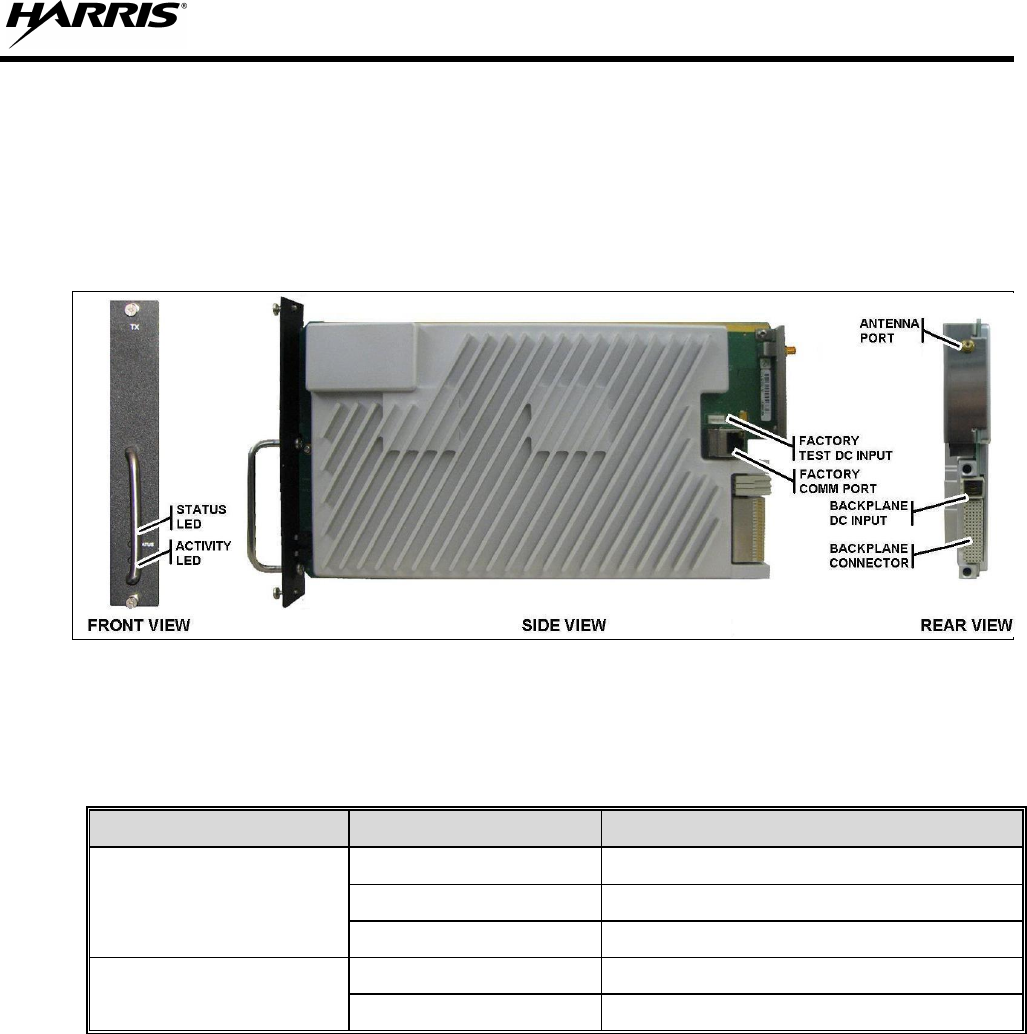
14221-5555-3210
17
All bands of MASTR V TX modules share common design features and meet stringent transmitter
specifications including the following:
• High output intercept point.
• 115.2 MHz 1st IF chosen for all bands of the MASTR V.
• Built-in hardware diagnostics (voltage supplies, PLL Lock).
• IQ data is sent from the Baseband Processor module for modulation.
Figure 4-5: TX Module
All electrical connections used during normal operation are located on the rear panel (refer to Figure 4-5).
Control, data, small signal, and DC power connections mate with the unified backplane. A TX output
connector is located on the rear panel.
Table 4-4: TX Module Connections
LOCATION
CONNECTOR
DESCRIPTION
Rear Panel
SMB JACK
Transmitter Exciter Output
95-Pin
Backplane Small Signal Connector (5X19)
3-Pin
Backplane DC Power
Circuit Board (side)
RJ-45
Factory Service Communications Port
4-Pin
Factory Service DC Power
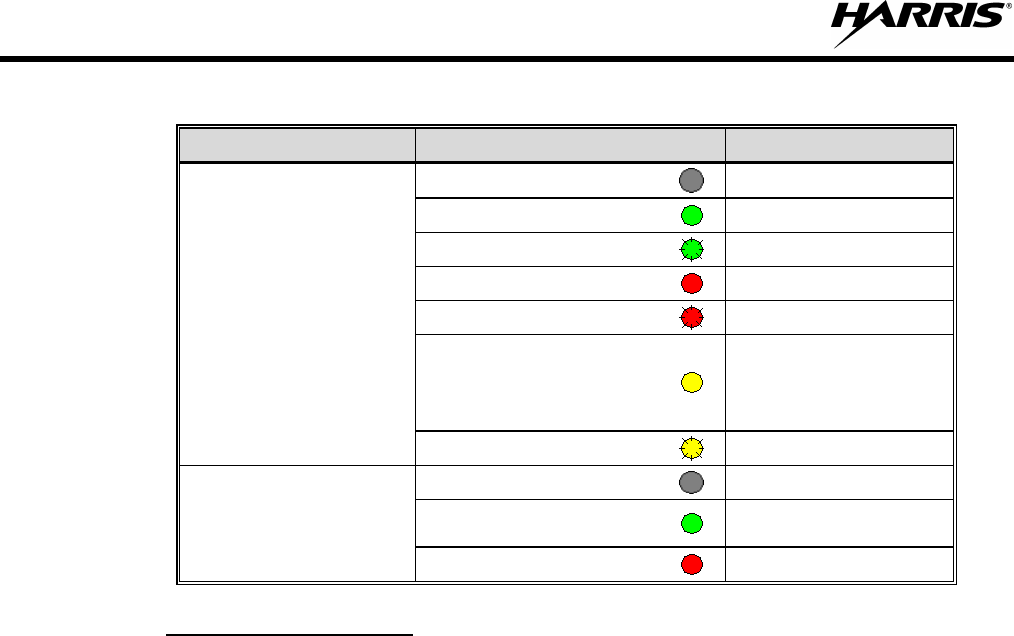
14221-5555-3210
18
Table 4-5: TX Module – Front Panel Indicators and Controls
INDICATOR/CONTROL
INDICATOR COLOR
DESCRIPTION
Status LED
OFF
No Status
GREEN SOLID
Transmitting
GREEN FLASHING
Exciter Mode
RED SOLID
Major Fault
RED FLASHING
Minor Fault
YELLOW SOLID
Flash Write (during
program modes)
Alternately, No Linearizer
Power Loop Packets
YELLOW FLASHING
Program Downloading
Activity LED
(Ethernet)
OFF
No Activity
GREEN SOLID
Ethernet Activity
RED SOLID
Loss of Ethernet Activity
4.4.3 Receiver Module (RX)
The MASTR V Receiver (RX) modules, model EA-555007-xxx, are dual-IF conversion receivers. The
receiver uses a Sigma-Delta analog to digital converter to process the incoming IF signal. The output of
the analog-to-digital converter is a complex pair of I/Q baseband digital signals. The MASTR V RX
module supports a wide range of modulation waveforms required for current and next generation public
safety two-way radio communications.
After IF filtering and down-conversion, received signals are digitized into I and Q information and sent to
the Baseband Processor module via the backplane Ethernet. The Baseband Processor module provides the
narrow channel filtering and demodulation. The narrow channel filters and digital demodulation is
performed by the system DSP, giving the MASTR V receiver the flexibility needed in current and future
LMR communications systems.
All bands of MASTR V RX modules share common design features and meet stringent receiver
specifications including the following:
• High intercept point.
• Low noise figure.
• 110.2 MHz IF chosen for all bands of the MASTR V.
• Automatic Level Control.
• Low side LO injection for superior noise performance.
• Built-in hardware diagnostics (voltage supplies, PLL Lock).
• Analog FM audio test jack (for factory use only).
• Raw IQ data is sent to the Baseband Processor module for demodulation.
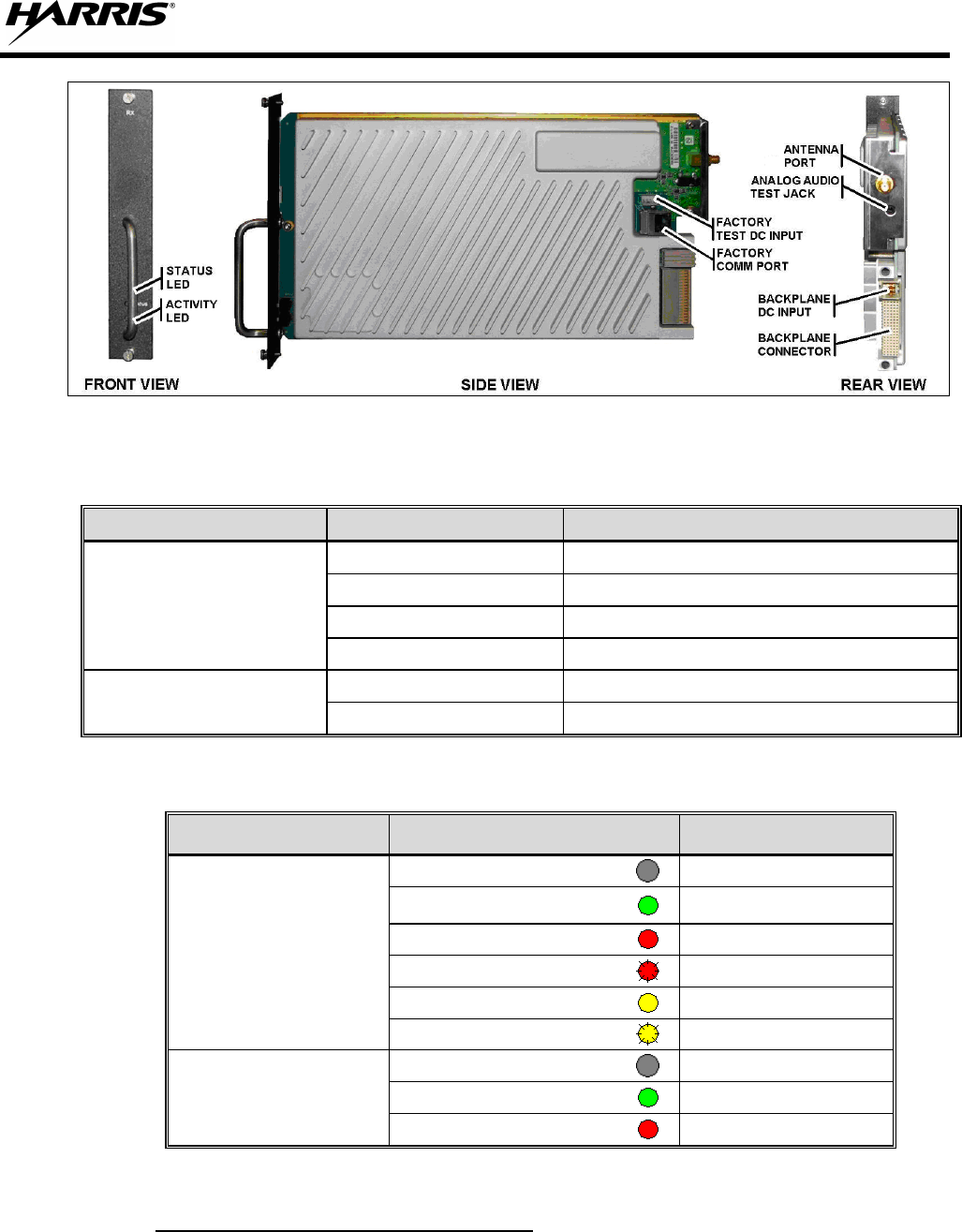
14221-5555-3210
19
Figure 4-6: RX Module
Table 4-6: RX Module Connections
LOCATION
CONNECTOR
DESCRIPTION
Rear Panel
SMA
Receiver Antenna Input
3.5 mm Stereo Phone Jack
Analog Receiver Audio (Test mode only)
95-Pin
Backplane Small Signal Connector (5X19)
3-Pin
Backplane DC Power
Circuit Board (side)
RJ-45
Factory Service Communications Port
4-Pin
Factory Service Port (DC Power)
Table 4-7: RX Module – Front Panel Indicators and Controls
INDICATOR/CONTROL
INDICATOR COLOR
DESCRIPTION
Status LED
Off
No Status
Green Solid
Receiving
Red Solid
Major Fault
Red Flashing
Minor Fault
Yellow Solid
Flash Write
Yellow Flashing
Program Downloading
Activity LED
(Ethernet)
Off
No Activity
Green Solid
Ethernet Activity
Red Solid
Loss of Ethernet Activity
4.4.4 Baseband Processor Module (BBP)
The Baseband Processor (BBP) module model EA-555005-001 provides several functions within the
MASTR V P25 Transceiver:
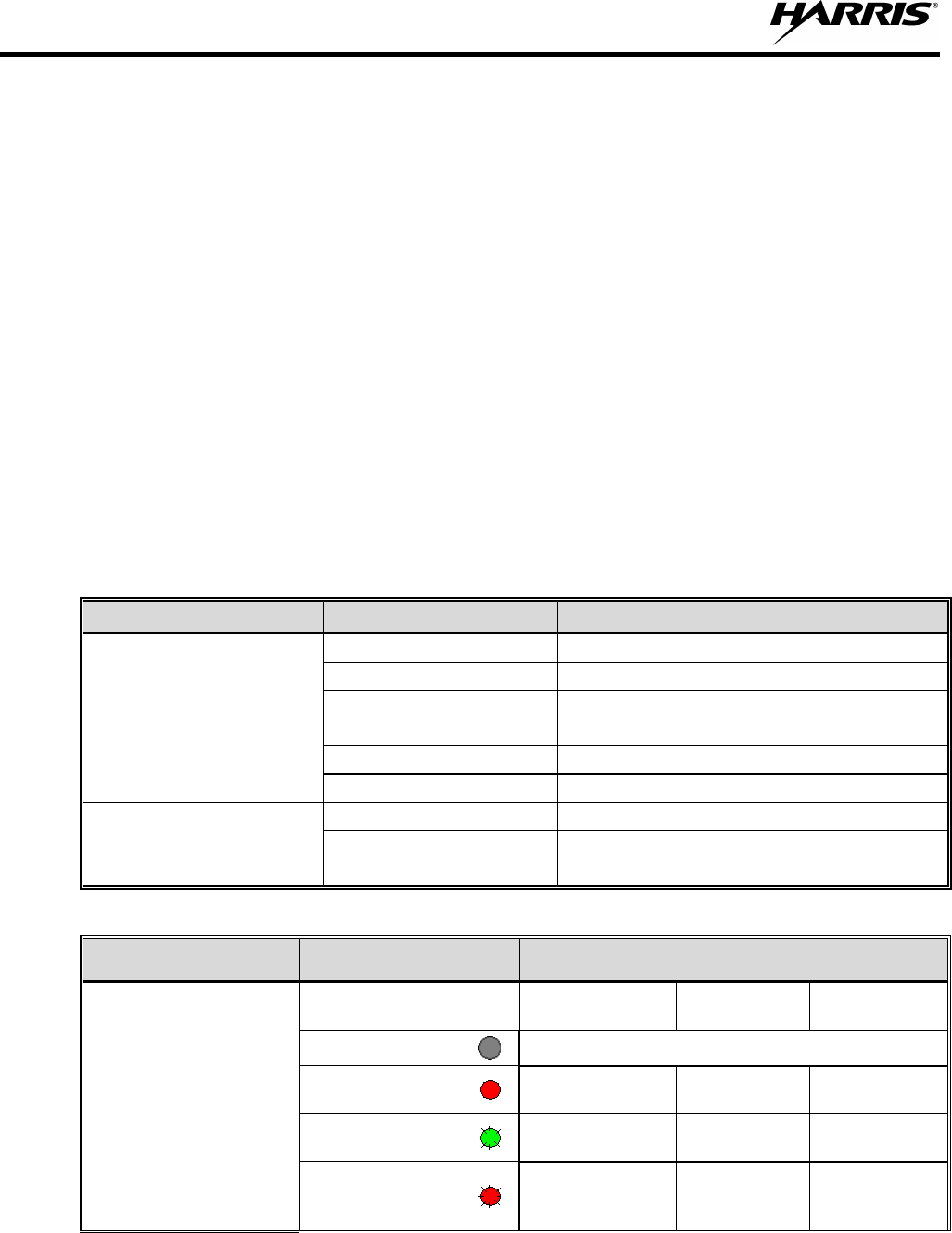
14221-5555-3210
20
• Generates all RX, TX, and Control Processing for one or more RF channels.
• Provides a data interface between the Traffic Controller the TX and RX modules.
• Generates a heartbeat message used to monitor the health of the transceiver modules.
When a MASTR V Transceiver is powered up, the TX, and RX modules will perform a discovery period
where they await a software request message from the BBP module assigned to manage that slot. When
the message is received, the module will respond with a software response message that prompts the BBP
to send the modules a personality message. The personality message will contain all personality data
(default initialization parameters). The modules respond with an acknowledgement for the personality
message, and then initialize themselves according to the personality data in the personality message. The
BBP module sends the modules a message to go operational. Once operational, the discovery and
initialization phase is complete. The BBP module periodically monitors the modules through heartbeat
messages. The BBP module also performs other vital roles, especially during a P25 Simulcast.
Heartbeat messaging is used to monitor the condition of the TX, and RX modules. Once operational, the
BBP module sends out heartbeat messages to each module. When a heartbeat message is received by a
module, the receiving module then sends a heartbeat message back to the BBP module. The heartbeat
monitor task keeps track of the time-stamps of the received heartbeat messages. A fault is registered if a
heartbeat message is not received within a predetermined time-frame. The heartbeat monitor also keeps
track of certain fault conditions.
Table 4-8: BBP Module Connections
LOCATION
CONNECTOR
DESCRIPTION
Rear Panel
SMA
10 MHz Time Base Input
DB-15HD
Simulcast Channel 1
DB-15-HD
Simulcast Channel 2
RJ-45
Ethernet MLAN
95-Pin
Backplane Small Signal Connector (5X19)
3-Pin
Backplane DC Power
Circuit Board (side)
RJ-45
Factory Service Port (Signaling)
4-Pin
Factory Service Port (DC Power)
Front Panel
USB
Field Service Communications Port
Table 4-9: BBP Module – Front Panel Indicators and Controls
INDICATOR/CONTROL
INDICATOR COLOR
DESCRIPTION
Reference LED
The BBP's Reference
LED uses each color to
denote the current
status of several
functions.
This is unlike LED
patterns used by other
MASTR V modules
where each LED color
MUX Delay
Controller
BBP Clock
Controller
GPS 10 MHz
Signal
Off
No Power
Red Solid
In Standby
Mode
In Standby
Mode
No Input from
GPS Receiver
Green Flashing
In Standby
Mode
In Standby
Mode
10 MHz OK
Red Flashing
In Standby
Mode
Providing
Clock Signal
to Shelf
No Input from
GPS Receiver
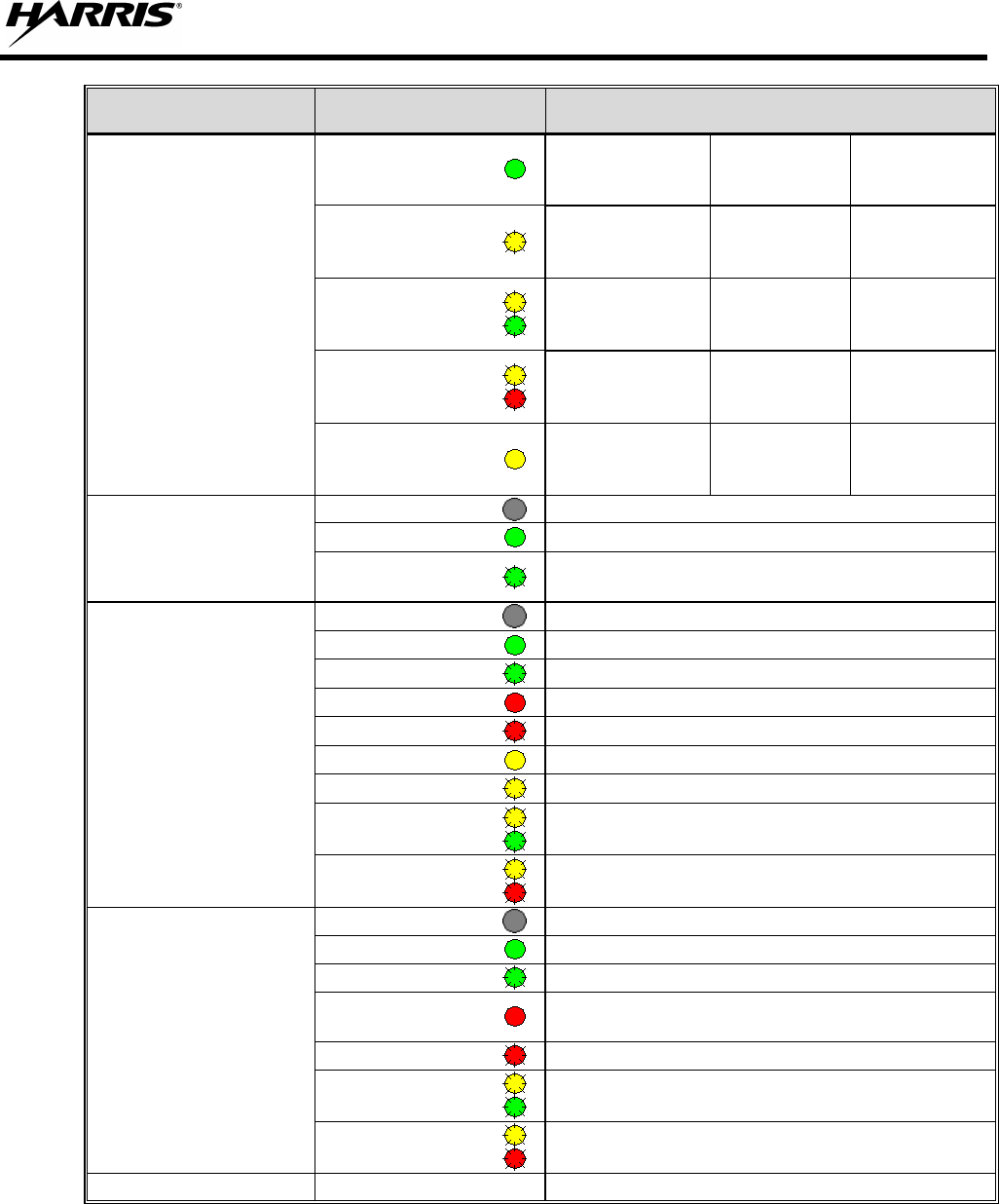
14221-5555-3210
21
INDICATOR/CONTROL
INDICATOR COLOR
DESCRIPTION
indicates the status of
only on
Green Solid
In Standby
Mode
Providing
Clock Signal
to Shelf
10 MHz OK
Yellow Flashing
Provide MUX
Delay Signaling
to Shelf
In Standby
Mode
No Input from
GPS Receiver
Yellow/Green
Flashing
Provide MUX
Delay Signaling
to Shelf
In Standby
Mode
10 MHz OK
Yellow/Red
Flashing
Provide MUX
Delay Signaling
to Shelf
Providing
Clock Signal
to Shelf
No Input from
GPS Receiver
Yellow Solid
Provide MUX
Delay Signaling
to Shelf
Providing
Clock Signal
to Shelf
10 MHz OK
Channel LED
Off
No Activity
Green Solid
Channel Inactive (no batch clock)
Green Flashing
Channel Active (batch clock present, 3 second
blink)
Status LED
Off
No Status
Green Solid
OK Status
Green Flashing
Running Loader Application
Red Solid
Major Fault
Red Flashing
Minor Fault
Yellow Solid
Flash Write
Yellow Flashing
Program Downloading
Yellow/Green
Flashing
USB Command Success
Yellow/Red
Flashing
USB Command Fail
Activity LED
Off
No Activity
Green Solid
Ethernet Activity
Green Flashing
Undefined (future use)
Red Solid
Major Fault (Missing heartbeat from a board
controlled by this BB)
Red Flashing
Minor Fault
Yellow/Green
Flashing
USB Command Success
Yellow/Red
Flashing
USB Command Fail
Reset Switch*
N/A
Software Reset
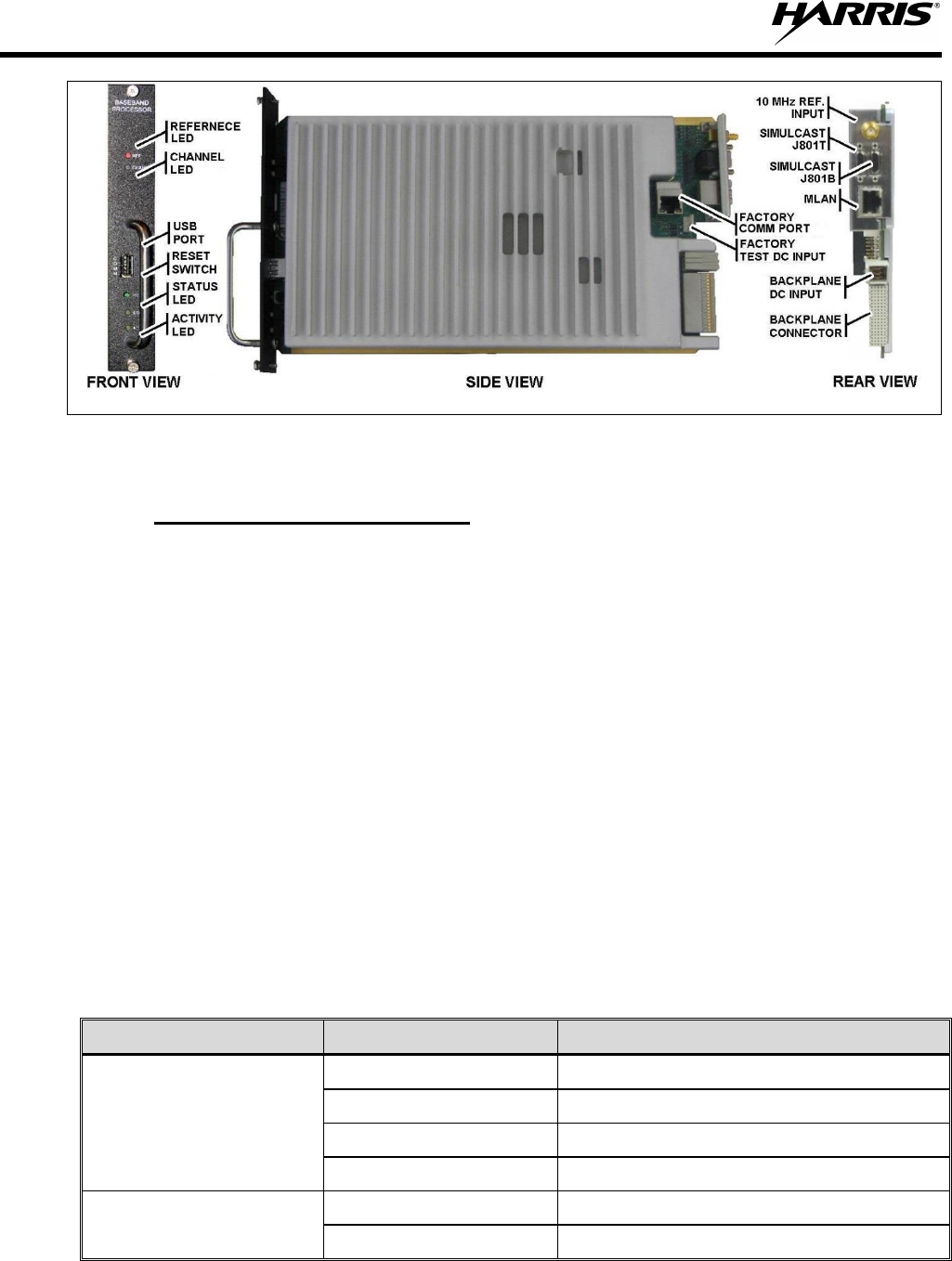
14221-5555-3210
22
Figure 4-7: Baseband Processor Module
4.4.5 Traffic Controller Module (TC)
The Traffic Controller (TC) module model EA-555004-001 performs interfacing for one (1) MASTR V
P25 RF channel. The TC module provides the following services:
• Data and control information for one (1) TX module.
• Data and control information for one (1) RX module.
• Generates the P25-formatted TX messages for over-the-air transmission.
• Provides VoIP interfacing to other P25 sites.
The TC module manages data and control information for one (1) TX and one (1) RX channel module.
Incoming data from dispatch points is processed into over-the-air P25-formatted TX messages. The TC
module processes decoded radio information received from the BBP module, and handles all aspects of
trunking (subscriber unit validation, assigned channels, queuing, etc.).
During P25 operation, the TC module interprets and directs inbound calls. It issues appropriate control
commands to and from the TX and RX modules, including how to handle data between the transceiver and
the Control Point.
The TC module also handles VoIP interfacing to other P25 sites. Receiver packets are formatted into a
VoIP-capable protocol and sent to other predefined P25 sites for retransmission.
Table 4-10: TC Module Connections
LABEL
CONNECTOR
DESCRIPTION
Rear Panel
RJ-45
Ethernet MLAN
RJ-45
Ethernet PLAN
95-Pin
Backplane Small Signal Connector (5X19)
3-Pin
Backplane DC Power
Circuit Board (side)
RJ-45
Factory Service Communications Port
4-Pin
Factory Service DC Power
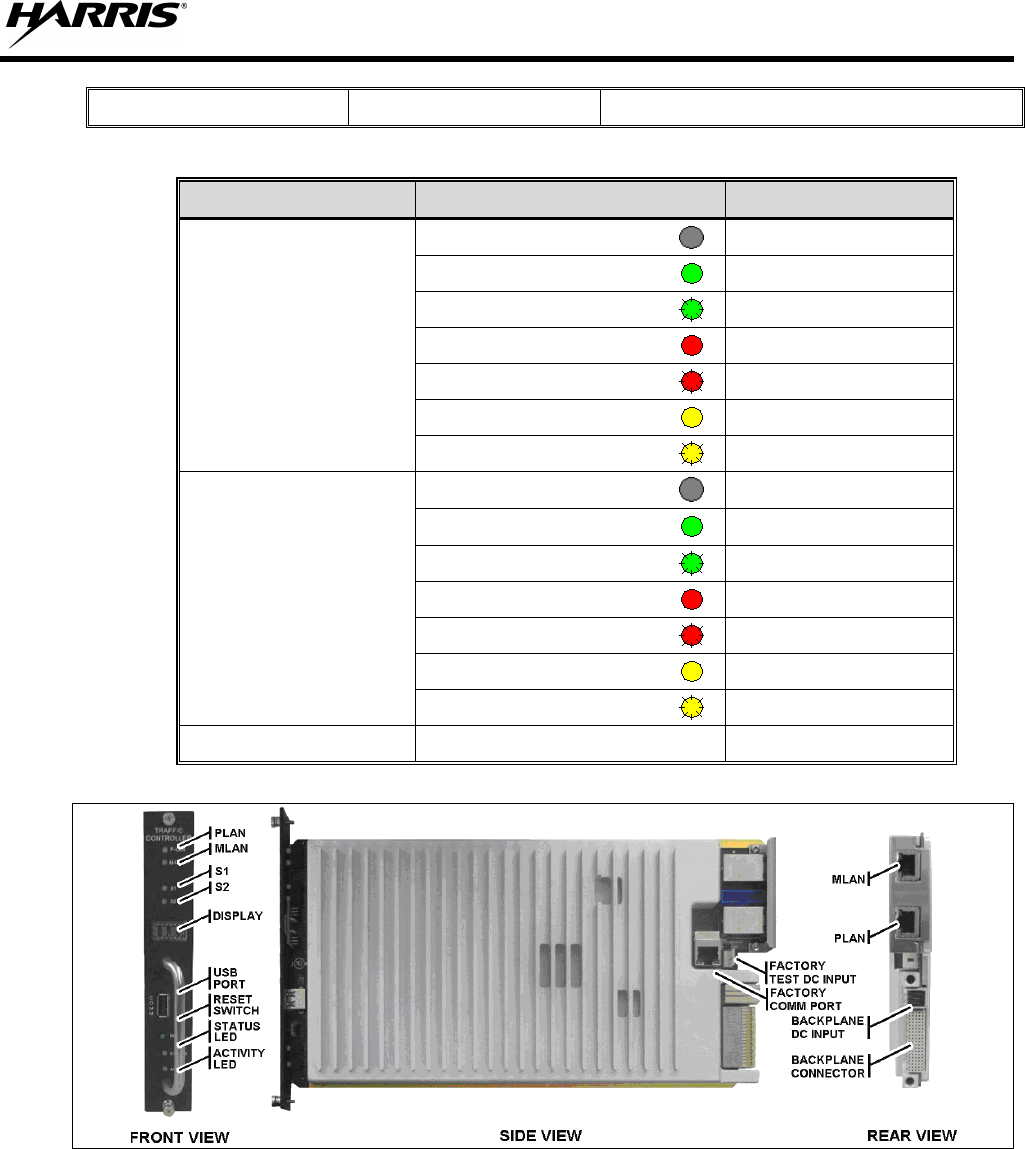
14221-5555-3210
23
Front Panel
USB
Service Communications Port
Table 4-11: TC Module – Front Panel Indicators and Controls
INDICATOR/CONTROL
INDICATOR COLOR
DESCRIPTION
Status LED
Off
No Status
Green Solid
RX/TX C-LAN
Green Flashing
Undefined (future use)
Red Solid
Major Fault
Red Flashing
Minor Fault
Yellow Solid
Flash Write
Yellow Flashing
Program Downloading
Activity LED
Off
No Activity
Green Solid
Ethernet Activity
Green Flashing
Undefined (future use)
Red Solid
Major Fault
Red Flashing
Minor Fault
Yellow Solid
Undefined (future use)
Yellow Flashing
Undefined (future use)
S1 and S2 LED
Undefined
Undefined (future use)
Figure 4-8: Traffic Controller Module
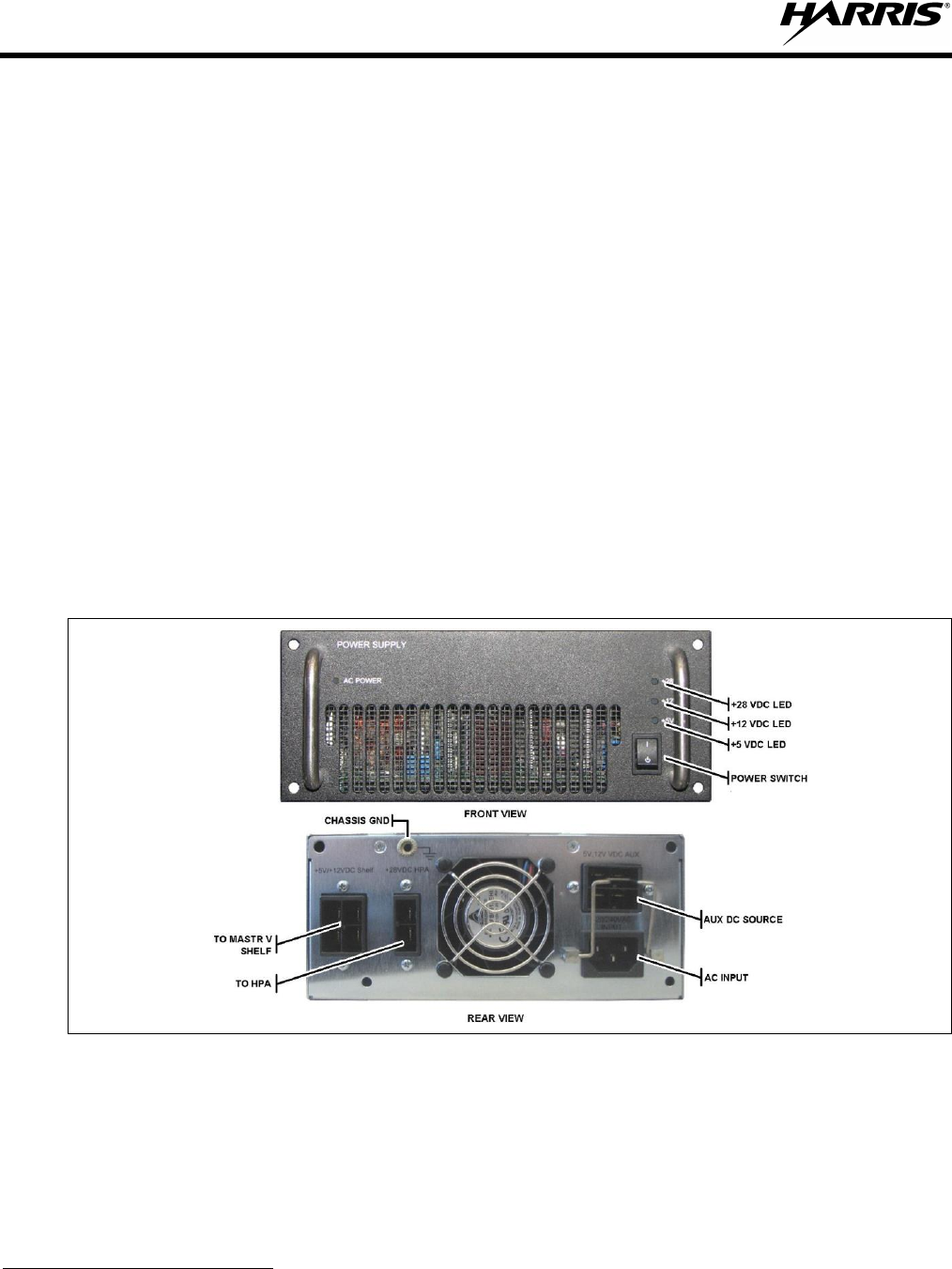
14221-5555-3210
24
4.4.5.1 Power Supply Module (PS)
The MASTR V AC Power Supply (PS) module EA-555011-001 (refer to Figure 4-9) and DC Power Supply
module EA-555001-003 (not shown) are continuous duty switching power supplies. The AC supply
operates from an input of 85 VAC to 265 VAC at 47 Hz to 63 Hz (1000 Watts maximum). The DC supply
operates from a -48VDC input and can operate from an input of -38 VDC to -57 VDC. Each PSU provides
a maximum of 865 Watts total output power divided among the following three (3) DC outputs:
EA-555011-001 (AC PS)
EA-555011-003 (DC PS)
• +28 VDC at 25 Amps
• +28 VDC at 25 Amps
• +12 VDC at 2.8 Amps
• +12 VDC at 5.0 Amps
• +5.0 VDC at 28 Amps
• +5.0 VDC at 15 Amps
Each MASTR V PS includes front panel LED status indicators for each DC output and power input. A
front panel ON/OFF switch used to disable the power supply and built-in cooling fan.
Three (3) DC power output connections are provided: one (1) to provide DC current to the MASTR V
multi-channel shelf, another to provide DC current to the HPA module
6
, and a spare DC connection.
The MASTR V PS is a negative ground power supply (the negative lead of each DC output is tied to chassis
ground). Over voltage, under voltage, and over current protection is built-into the AC input, and each DC
output. In the event one of the protection circuits is triggered, only the affected DC output is shut down
until the protection circuit is reset.
Figure 4-9: Power Supply Module
6
Not used in MASTR V Transceiver configuration.
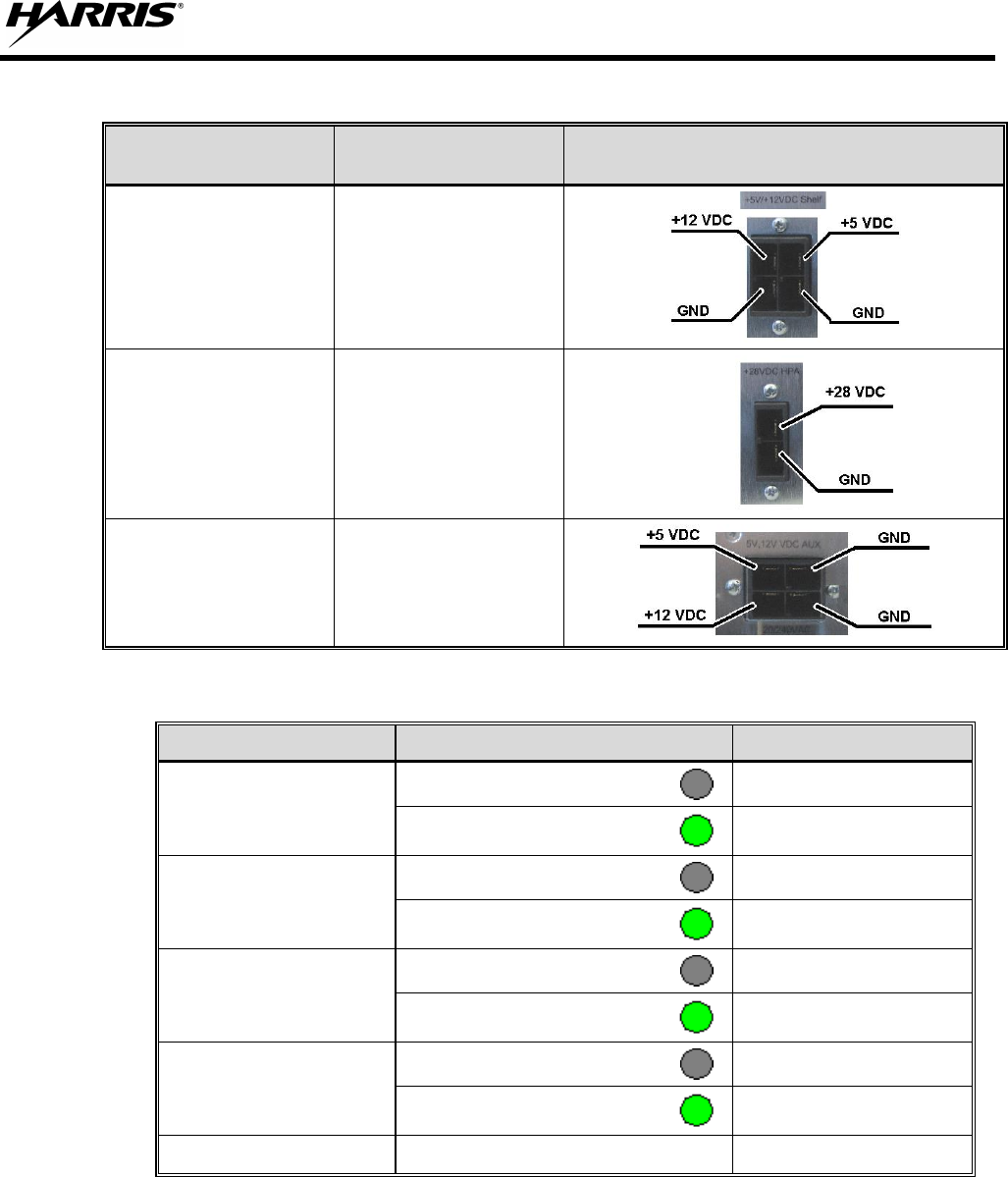
14221-5555-3210
25
Table 4-12: Backplane – Module DC Power Connector Pinout
CONNECTOR
LABEL
DESCRIPTION
DIAGRAM
(As viewed when facing the rear of the PS)
+5V/+12VDC Shelf
To MASTR V T/R Shelf
+28VDC HPA6
To HPA Module
5V,12V VDC AUX
Auxiliary/Spare
Table 4-13: PS Front Panel Indicators and Switches
INDICATOR/CONTROL
INDICATOR COLOR
DESCRIPTION
+28 VDC LED
Off
OFF or not operational
Green Solid
Operational
+12 VDC LED
Off
OFF or not operational
Green Solid
Operational
+5 VDC LED
Off
OFF or not operational
Green Solid
Operational
AC Power LED
Off
OFF or not operational
Green Solid
Operational
ON/OFF Switch
N/A
AC Power ON/OFF
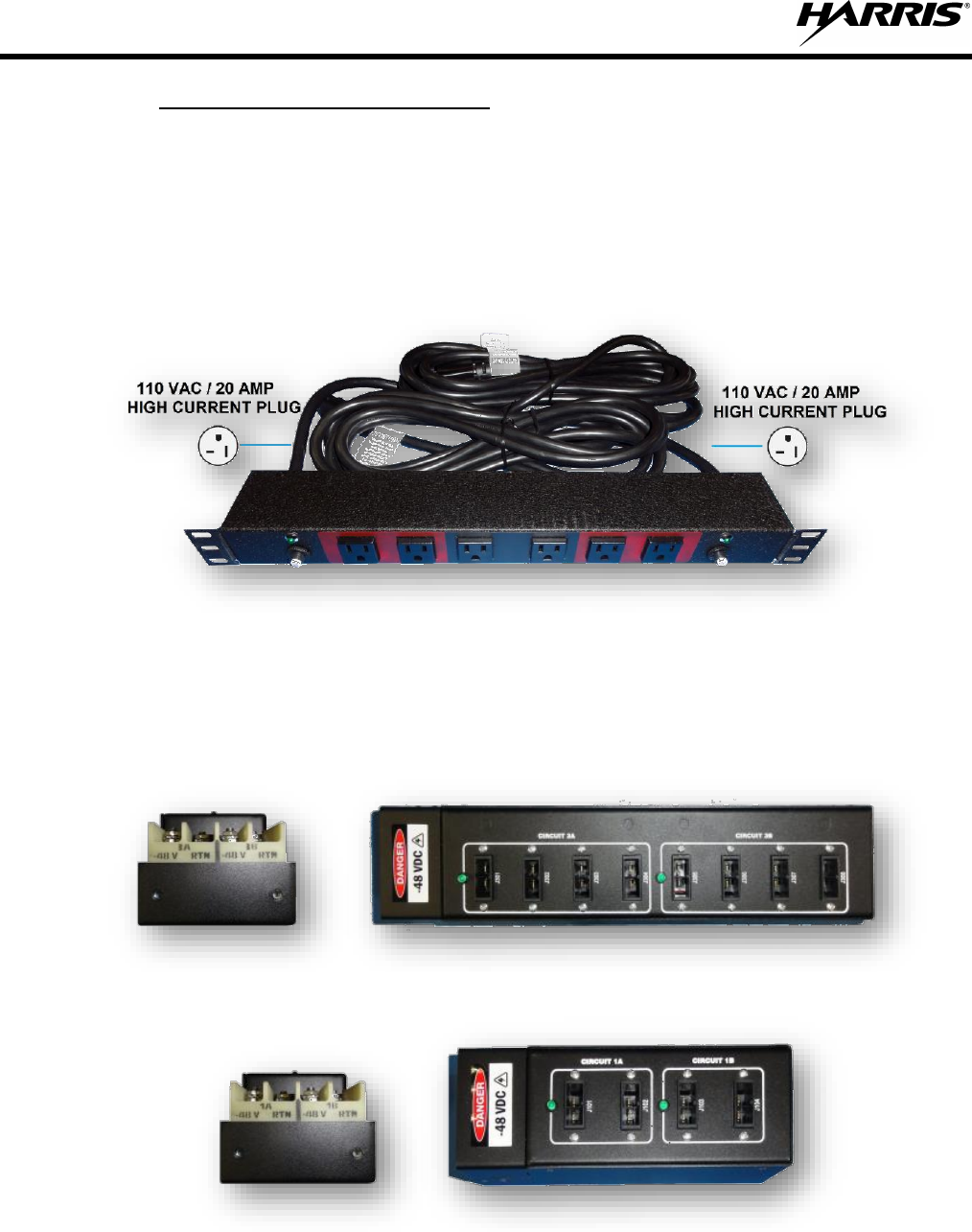
14221-5555-3210
26
4.4.6 AC and DC Power Distribution
AC powered sites use specially designed dual input AC power distribution strips, model DP-016706-001
(for 120VAC applications, shown in Figure 4-10) and DP-016706-002 (for 220VAC applications, not
shown). Each AC power strip has two (2) circuit protected high current inputs (110 VAC, 20 Amp and
220VAC, 15 Amp, respectively). Each high-power input is distributed to three (3) AC outlets for a total of
6 outlets per power strip. The housing around two outlets on each circuit are silk screened with red as an
indication of where to connect the high current MASTR V power supplies used at transceiver rack-ups.
The red only designates use, not rating.
Figure 4-10: Dual input 120VAC Power Distribution Strip
DC powered sites use DC Power Distribution Blocks, models EA-555019-001 (low power) and
EA-555019-002 (high power). Each DC Distribution Block is designed to distribute -48 VDC from two
(2) DC input circuits. Like the AC model, distribution across two circuits reduces the area on the rack’s
rear rails required to mount multiple power strips and distributes the load across multiple circuits which
minimizes the number of hardware devices which fail when circuit protections trips.
Figure 4-11: EA-555019-001 – -48 VDC Low Power DC Distribution Strip
Figure 4-12: EA-555019-002 – -48 VDC High Power DC Distribution Strip
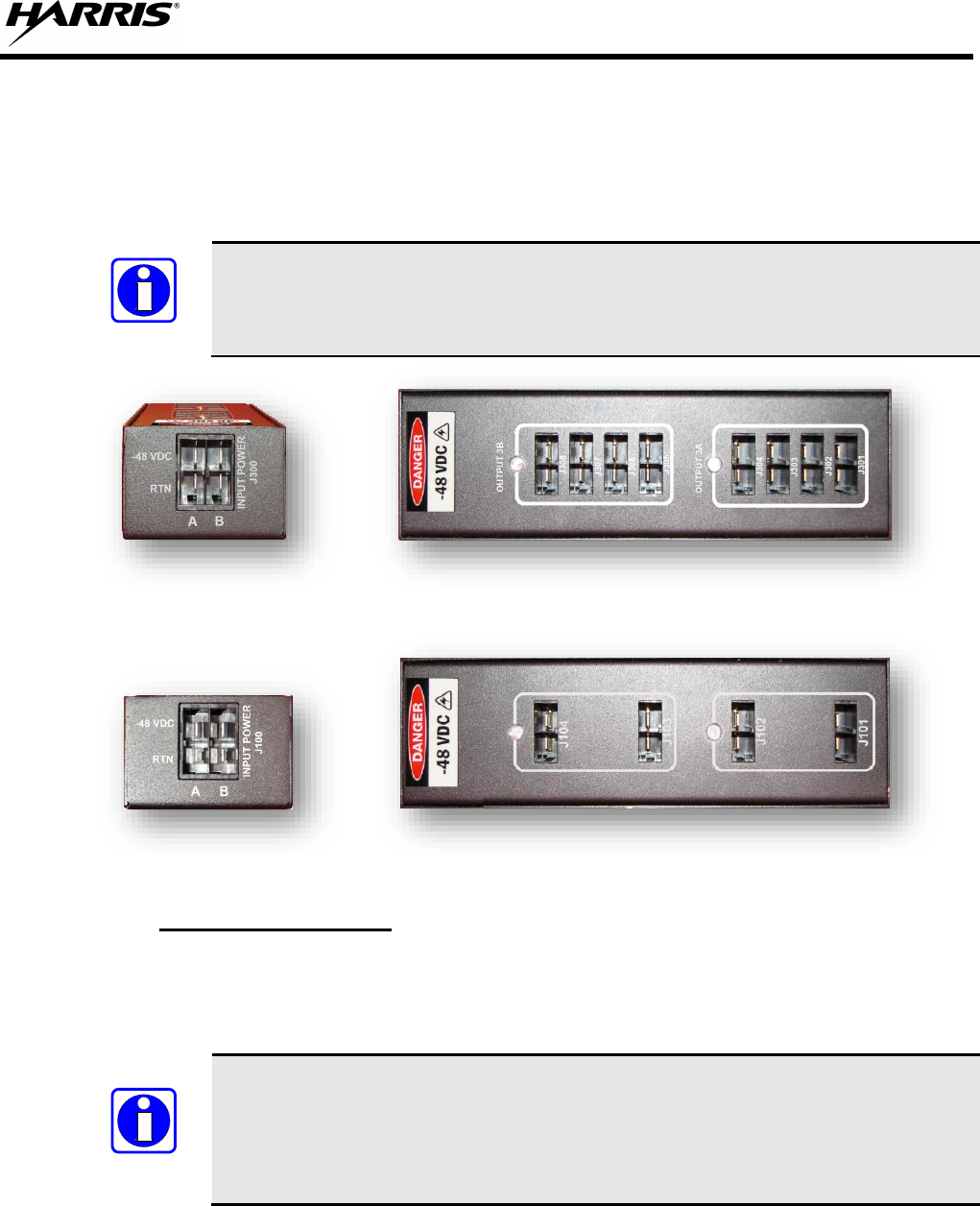
14221-5555-3210
27
DC-powered MASTR V sites may use the enhanced DC Power Distribution Blocks, models
EA-555019-003 (low power) and EA-555019-004 (high power). Similar in function to the DC Power
Distribution blocks shown in Figure 4-11 and Figure 4-12, the enhanced versions include connector
assemblies for the DC input connections. The addition of DC input connectors provides ease of installation
and improves performance of the MASTR V DC distribution. An external DC power disconnect device
shall be provided and installed as part of the DC system supplying power to the MASTR V rack.
For permanently connected equipment, a readily accessible disconnect device shall be
incorporated external to the equipment.
Figure 4-13: EA-555019-003 – Enhanced -48 VDC Low Power DC Distribution Strip
Figure 4-14: EA-555019-004 – Enhanced -48 VDC High Power DC Distribution Strip
4.4.7 Cross-Connect Panel
The MASTR V IP Cross-connect panel, model number EA-555016-002, includes printed circuit board
CB-555149-002 and a 2-RU high metal frame for accommodating 19-inch rack mounting the board. One
or more Cross-connect panels are installed at all MASTR V P25 sites. Additional cabling at the Cross-
connect panel is installed when a site is setup to support Phase 2.
- - - P25 Trunked Phase 2 Operation - - -
• Cross-connect panels are installed at all MASTR V P25 Phase 2 equipped trunked
sites which use two (2) or more Baseband modules.
• Additional cabling is installed at the Cross-connect panel to support P25 Phase 2.
The Cross-connect board provides distribution of timing signals between two (2) or more Baseband
modules at a site. It also provides distribution of timing signals between two (2) or more racks or cabinets
containing MASTR V transceiver shelves.
NOTE
NOTE
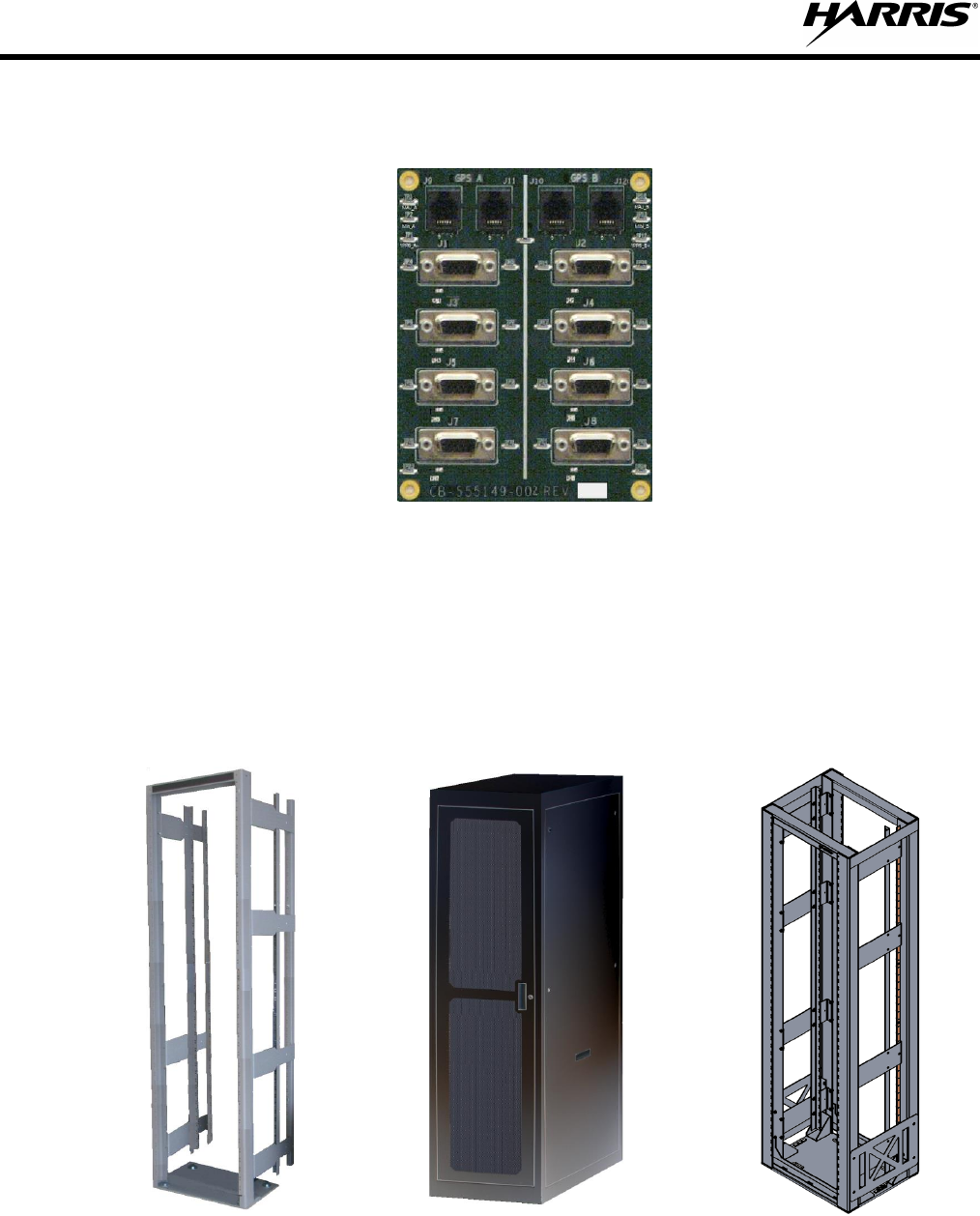
14221-5555-3210
28
The timing signals passing through the Cross-connect board to each Baseband module are used to
synchronize operations between each RF channel and ensure smooth transition between Control Channel,
Working Channel, and timeslot operations.
Figure 4-15: IP Simulcast Cross-Connect Board CB-555149-002
4.5 RACK AND CABINET ASSEMBLIES
This MASTR V transceiver configuration is available in an extra deep 86-inch x 46-RU open rack, part
number BAT 150 196/22 (refer to Figure 4-16), an extra deep 86-inch x 45-RU cabinet, part number
MA-555025 series (refer to Figure 4-17), and a seismic rated open rack, part number BAT150196/24 (refer
to Figure 4-18). Each model supports installation of 19-inch rack mountable equipment. Cabinet, part
number 14002-1000-11 (not shown), supports installations where CE/ETSI requirements apply.
Figure 4-16: 86-inch
Open Rack Assembly
Figure 4-17: 86-inch
Extra Deep Cabinet
Figure 4-18: Seismic
Rated Open Rack
Assembly
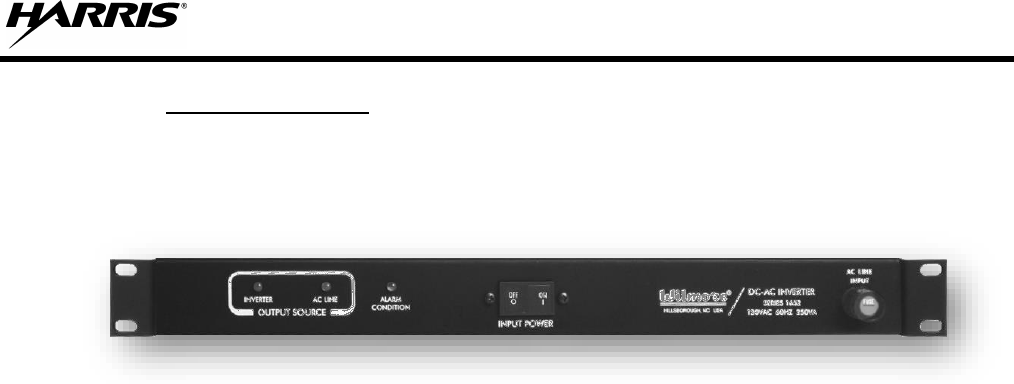
14221-5555-3210
29
4.5.1 DC-to-AC Inverter
DC-powered sites using the Harris Extra Deep Cabinet may require a DC-to-AC Inverter, part number A10-
0326-001, to power the cabinet fan. Initial releases of the 86-inch Extra Deep Cabinet use an AC-powered
cabinet fan for forced ventilation. The inverter is required to power this fan at DC-powered sites. Later
models of the cabinet may include an optional DC-powered fan which would eliminate the inverter.
Figure 4-19: DC-to-AC Inverter Used to Power the Cabinet Fan at DC-Powered Sites

14221-5555-3210
30
5. PROGRAMMING, TEST, AND DIAGNOSTICS
5.1 VIDA DEVICE MANAGER
Setup, configuration, and programming of a MASTR V P25 Trunked transceiver is accomplished through
the use of the VIDA Device Manager programming software tool. VIDA Device Manager is an easy-to-
use programming tool designed around a Windows-based file management system that permits users to
configure and manage devices within their system. The user can save/open personalities using the Windows
file system.
The user interface, known as the Device Management Console (DMC), allows users to configure and
manage IP-accessible devices in their MASTR V radio system. It allows users to edit device Personalities
and permits users to perform actions such as the following:
• Reset
• Read Version
• Load Code
• Read Personality
• Write Personality
The DMC stores device connection information and all personalities (by default) for the supported devices
within the radio system. The information stored includes device definitions, device plug-ins, device Client
plug-ins, device personalities, device code, device connections, and device details. The Repository provides
an interface to access, modify, and create the information.
5.2 TEST AND DIAGNOSTICS
The MASTR V transceiver has built-in self diagnostics and fault reporting. Transceiver faults may be
remotely monitored via fault reporting from one or more of the following resources:
• Via the VIDA network through the Regional Network Manager.
• By telnet session while connected locally to a MASTR V transceiver.
The TC module and BBP modules are capable of reporting fault information via the VIDA Network to the
Regional Network Manager (RNM). The RNM has the ability to “Poll” the status of certain equipment,
and “Trap” responses to log files. For more information regarding RNM polling and trapping, refer to the
Regional Network Manager User Manual: MM1000018633.
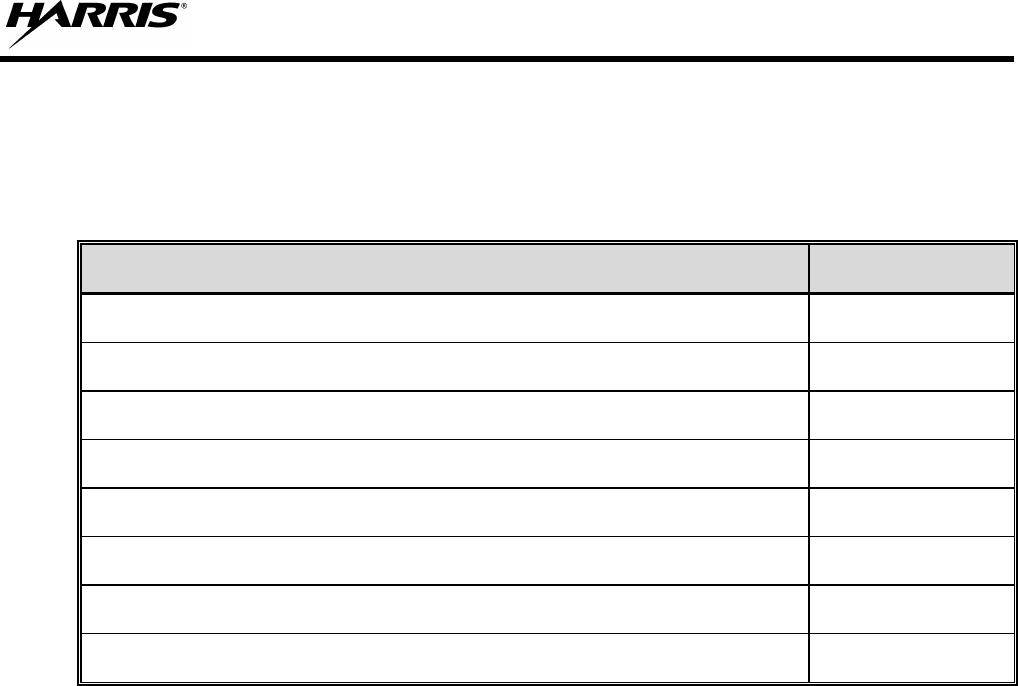
14221-5555-3210
31
6. REFERENCE MANUALS
The following table provides a listing of individual manuals that may be useful when installing and
maintaining a MASTR V P25 Transceiver:
Table 6-1: Reference Manuals
REFERENCE MANUALS
MANUAL NUMBER
Standard For Site Grounding and Protection Manual
AE/LZT 123 4618/1
Electrostatic Discharge Protection Manual
LBI-38737
Specification, Guidelines & Practices Manual
LBI-39185
Antenna Systems Manual
LBI-38983
MASTR V P25 Base Station Installation Manual
MM-015040-001
MASTR V P25 Base Station Application/Assembly Diagrams Manual
MM-015041-001
VIDA Device Manager User’s Manual
MM-016371-001
VIDA Network Regional Network Manager User’s Manual
MM1000018633

14221-5555-3210
32
7. CUSTOMER SERVICE
7.1 TECHNICAL SUPPORT
The Technical Assistance Center's (TAC) resources are available to help with overall system operation,
maintenance, upgrades and product support. TAC is the point of contact when answers are needed to
technical questions.
Product specialists, with detailed knowledge of product operation, maintenance and repair provide technical
support via a toll-free (in North America) telephone number. Support is also available through mail, fax
and e-mail.
For more information about technical assistance services, contact your sales representative, or contact the
Technical Assistance Center at the following:
North America: 1-800-528-7711
International: 1-434-385-2400
Fax: 1-434-455-6712
E-mail: PSPC_tac@harris.com
7.2 TECH-LINK ONLINE SERVICES
For more information about this and other Harris PSPC products, check out our Tech-Link service at:
https://premier.pspc.harris.com/
Tech-Link is a one stop link to Technical Documentation (downloadable PDFs) - Software Revisions -
Feature Encryption - pictorials of parts and accessories - and other information pertaining to our products.
Information that will enhance your service efforts -- 24 hours a day, 7 days a week.
7.3 CUSTOMER CARE
If any part of the system equipment is damaged on arrival, contact the shipper to conduct an inspection and
prepare a damage report. Save the shipping container and all packing materials until the inspection and the
damage report are completed. In addition, contact the Customer Care center to make arrangements for
replacement equipment. Do not return any part of the shipment until you receive detailed instructions from
a Harris representative.
Contact the Customer Care center at https://www.harris.com//solution/pspc-customer-service or:
North America:
Phone Number: 1-800-368-3277
Fax Number: 1-321-409-4393
E-mail: PSPC_CustomerFocus@harris.com
International:
Phone Number: 1-434-455-6403
Fax Number: 1-321-409-4394
E-mail: PSPC_InternationalCustomerFocus@harris.com

14221-5555-3210
33
8. WARRANTY
Please register this product within 10 days of purchase. Registration validates the warranty coverage, and
enables Harris to contact you in case of any safety notifications issued for this product.
Registration can be made on-line at the Customer Care center webpage:
https://www.harris.com//solution/pspc-customer-service
While on the webpage, please review the applicable battery and/or product warranty literature.
